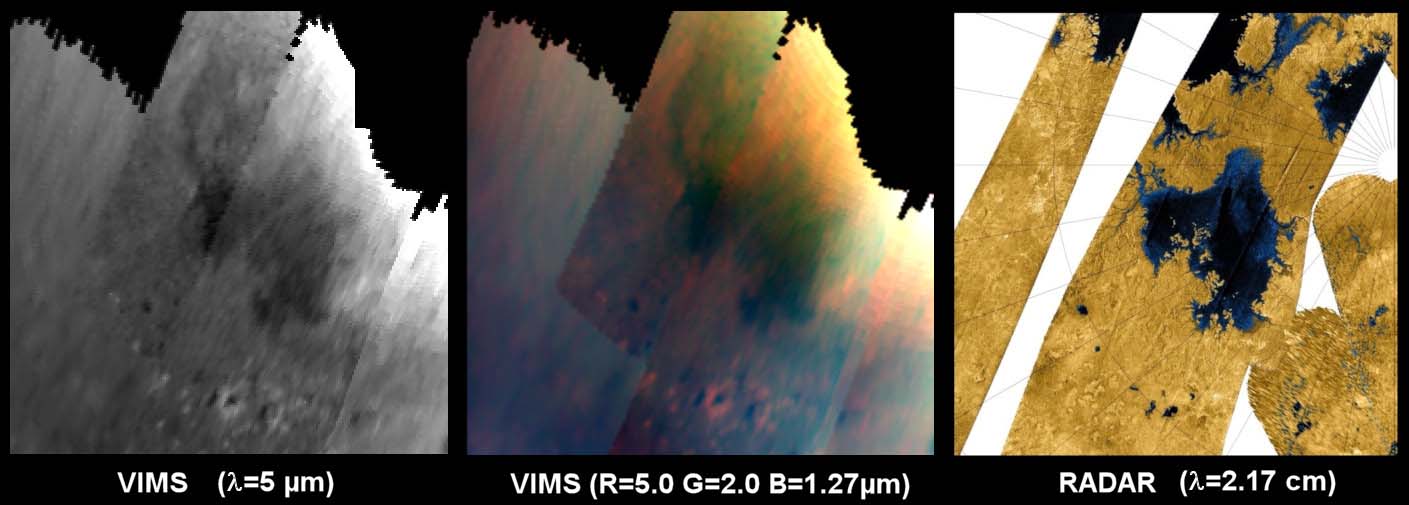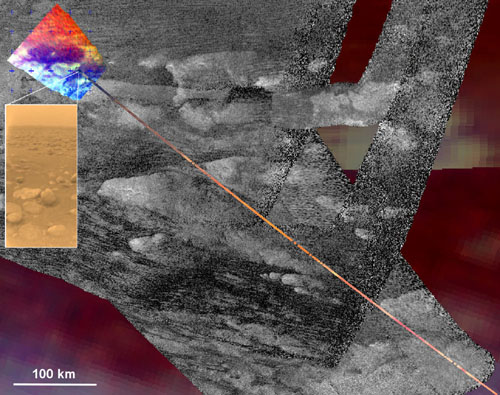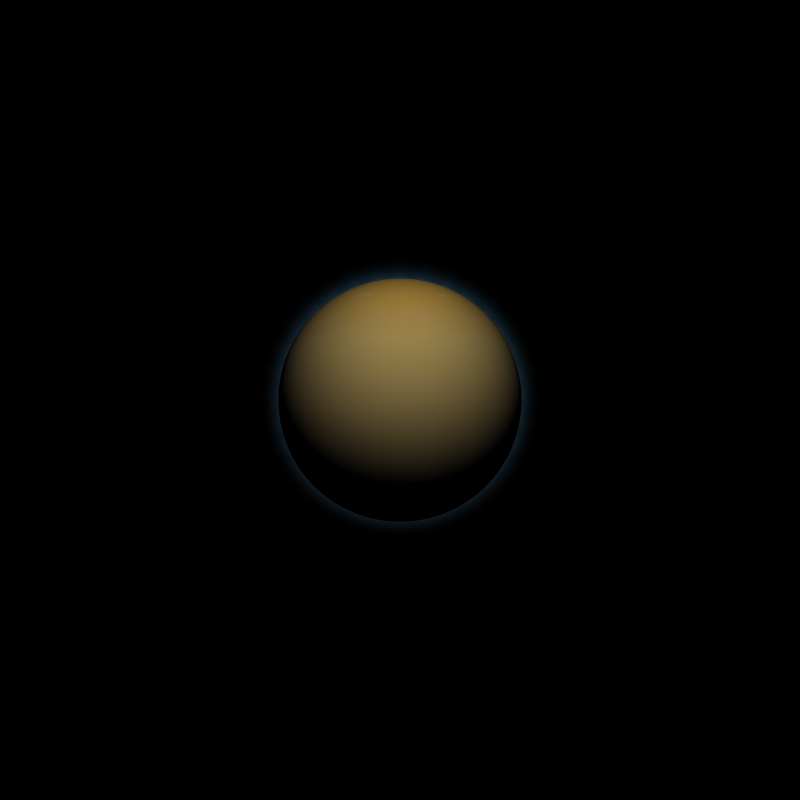Titan News 2011
December 19, 2011: Is there a Liquid Methane Habitable Zone?
Thanks to the space observatories Corot and Kepler, planetary scientists have been able to detect or identify numerous extrasolar planets or exoplanets. The characteristics of the exotic planets found are closely related to their mass, the mass of the star or the type of star as well as the distance of the orbit of the planet from the star. The discoveries have been made using the technique of transits and the technique of radial velocity Doppler shifts.
The diversity of environmental conditions in those exoplanets pushes us into developing new hypotheses upon the concept of Habitable Zone. When we talk about Habitable Zone, we talk about the range of distances from the star at which water can appear in its liquid form. If a planet or a moon has lakes or seas of liquid water, it is likely that it will host a water-based life since liquid water is believed to represent the best solvent for life to develop.
However, the finding of rivers, lakes and seas on Saturn's largest moon Titan shows that liquid methane and liquid ethane may represent a potential solvent for the development of a methane or ethane-based lifeform.
As a result, we may include the Liquid Methane Habitable Zone in the traditional concept of Habitable Zone. The Liquid Methane Habitable Zone may simply be the range of distances at which methane can appear in its liquid form.
We know that carbon atoms are key elements of life on Earth. Methane incorporates a carbon atom as well as hydrogen elements. Both elements are incorporated into our Terrestrial biology. The human body is roughly made of 65% water and 35% carbon. The key elements of the life we know are Carbon, Hydrogen, Oxygen, Nitrogen, Phosphorus and Sulphur.
Liquid water is widespread on Earth and it seems to be the best solvent for the development of any lifeform because water molecules easily move around in cells. Moreover, water has a high heat capacity, the ability to remain in liquid form across a wide temperature range and a molecular density that enables it to act as a building block around which the molecules are forced to organize themselves.
The environmental temperature on the surface of the Orange Moon Titan is very low. The Huygens probe which landed in the Adiri/Shangri-La region in the low latitudes of Titan's southern hemisphere on January 14, 2005 recorded a surface temperature of 94K, -179 degrees Celsius or -290 degrees Fahrenheit as well as an atmospheric pressure of 1467 hPa. Therefore, water can't appear in its liquid form on Titan. Water would be as solid as rock on its soil.
The famous astrobiologist and planetary scientist Chris McKay of NASA's Ames Research Center explained: "We live on a planet where water is a liquid and we have adapted and evolved to work with that liquid."..."Life has very cleverly used the properties of water to do things not just in terms of solution, but in using the strong polarity of that solution to its advantage in terms of hydrophobic and hydrophilic bonds, and using the very structure of water to help align molecules."
Titan is the only known extraterrestrial body to harbour lakes, seas and rivers on its surface. Pools of liquid hydrocarbons, probably corresponding to mixtures of methane and ethane, have been clearly identified in the south polar region and in the high latitudes of the northern hemisphere of the Opaque Moon. Are the lakes or seas Kraken Mare, Ligeia Mare and Ontario Lacus stable over time? Are there strong evaporation processes and precipitations? The question of the stability of the lakes and seas is important because life is thought to need a stable solvent to develop.
The methane cycle of Titan is not well understood, yet. A Titanian year lasts roughly 29.5 years and each season is about seven Earth years. It appears that the arid, dark low-latitude regions of the moon have undergone strong precipitations in the past because large, transient cloud systems have been recently observed over the low latitudes of Titan. And the images taken from the Huygens probe during its atmospheric descent revealed bright hills made of dark fractures or drainage channels.
Therefore, hydrocarbons may be too volatile on the ground of the low latitudes for exotic lifeforms based on methane and ethane to emerge or develop. It seems that the north polar region of Titan presents the ingredients and the environmental conditions suitable for the development of a methane-based life. Liquid hydrocarbons seem relatively stable in that area, indeed. The methane/ethane cycle appears relatively dynamic in that area since a large ethane cloud system engulfing the area has been clearly observed.
Chris McKay as well as Ashley Gilliam of NASA's Ames and the University of California, Santa Cruz released a paper in the journal Planetary and Space Science in April 2011 related to the Methane Habitable Zone around a red dwarf star. They calculated, for the star Gliese 581, that the surface temperature of a planet can be at -179 degrees Celsius between 0.63 astronomical units and 1.66 astronomical units or between 99 million kilometers and 248 million kilometers.
The star Gliese 581 is known to be an M3-type red dwarf located 20.5 light years away. In our search for extra-solar planets, we may have found a planet orbiting Gliese 581 at 0.76 astronomical units which is inside the range of the Liquid Methane Habitable Zone. Further studies are needed to confirm that information.
The cooler the star, the closer the Liquid Methane Habitable Zone will be. For instance, with a M4 type red dwarf, the distance range of the Liquid Methane Habitable Zone may be between 0.084 astronomical units and 0.23 astronomical units or between 12.6 million kilometers and 34.4 million kilometers.
The analysis related to the Liquid Methane Habitable Zone appears to be quite complicated because we must take into account the amount of energy reaching the planet, the gravity of the planet, the composition of the atmosphere of the planet, the atmospheric pressure on the surface as well as factors such as the rotation speed of the planet and the type of star.
The type of star appears to be an important factor because Red Dwarfs or Red Giants tend to emit more red light than our Sun and we know that red and infrared light tend to penetrate Titan's atmosphere and reach its surface more easily than green and blue wavelengths.
A higher amount of red light and infrared light may engender a higher greenhouse effect, hence warming the planet. Therefore, this factor leads us to put the distance range of the Liquid Methane Habitable Zone farther from the star.
What will happen to Titan when the Sun turns into a Red Giant? Will we find pools of liquid propane, liquid butane? Or, will it be possible to find pools of liquid water in a cosmic area where water molecules are widespread? Will the atmosphere still be there?
Red dwarfs are known to be highly magnetically active, generating large stellar flares. Those stellar flares are likely to emit higher amounts of ultraviolet radiation which will tend to dissociate molecules of hydrocarbons in the atmosphere and to form a thicker haze.
The thicker haze may act as an anti-greenhouse barrier leading to a colder surface than that with a less dense haze. In that configuration, the Liquid Methane Habitable Zone will be closer to the star because of the anti-greenhouse effects.
Chris McKay and Heather Smith of the International Space University in Strasbourg published, in 2005, a paper suggesting the possibility of a methane-based life form on the Orange Moon Titan. Titan may have the methane cycle, the ingredients and the chemical processes for a methane-based lifeform to emerge and develop.
A depletion of hydrogen, acetylene and ethane may take shape at the surface. How could it be explained? Scientists suggest the hypothesis of methanogens that could consume hydrogen, acetylene and ethane and breathe out methane instead of carbon dioxide.
Regarding our quest for habitable exoplanets, Chris McKay pointed out: "It's not clear that we could be able to see the depletion of hydrogen over interstellar distances."..."On Earth, of course, the big biosignature that is visible over interstellar distances is the build-up of oxygen, but even that is not an unambiguous indicator for life, because for most of Earth's history there has been life but no build-up of oxygen."
Jonathan Lunine of the University of Arizona notes that planets similar to Titan may be more numerous than planets similar to Earth. That could imply, if the theory of the Liquid Methane Habitable Zone is correct, that lifeforms based on methane are more widespread in the galaxy and the Universe than lifeforms based on liquid water. Let's note, however, that lifeforms based on methane may have a very slow metabolism in a harsh environment similar to that of Titan.
Lisa Kaltenegger of the Max Planck Institute in Germany and of the Harvard-Smithsonian Center for Astrophysics argued: "You would have to invoke a lot of pressure to keep methane liquid at warmer temperatures."..."And if you think about it, water and carbon are extremely abundant. So if you make the planet warmer, you are much more likely to get carbon dioxide than methane, and methane would go out of its liquid phase so you wouldn't have the triple point [where for a given temperature and pressure a material can exist as a liquid, solid or gas] like the triple point of water on Earth."
Astrobiologists have envisaged several substitutes for carbon and water in biochemistry processes: some astrobiologists emit the hypothesis of a silicon-based life, the hydrogen fluoride-based life or liquid salt-based life. On the basis of the observations of Titan's surface, methane-based life and ethane-based life appear to be the strongest hypotheses. Chris McKay advanced: "I can imagine a world where there is sodium chloride liquid and salt is somehow the basis for life."
The presence of large amounts of liquid hydrocarbons, methane/ethane lakes, seas and rivers in the high latitudes of Titan's northern hemisphere strengthens the hypothesis of Marc Lafferre and Guilhem Cournot proposed in 2004 throughout their model of a methane-based life in which animals absorb liquid ethane, breathe in hydrogen and breathe out methane and plants breathe in methane and breathe out hydrogen via a methane cycle comparable or similar to the water, oxygen, CO2 cycle of Terrestrial lifeforms.
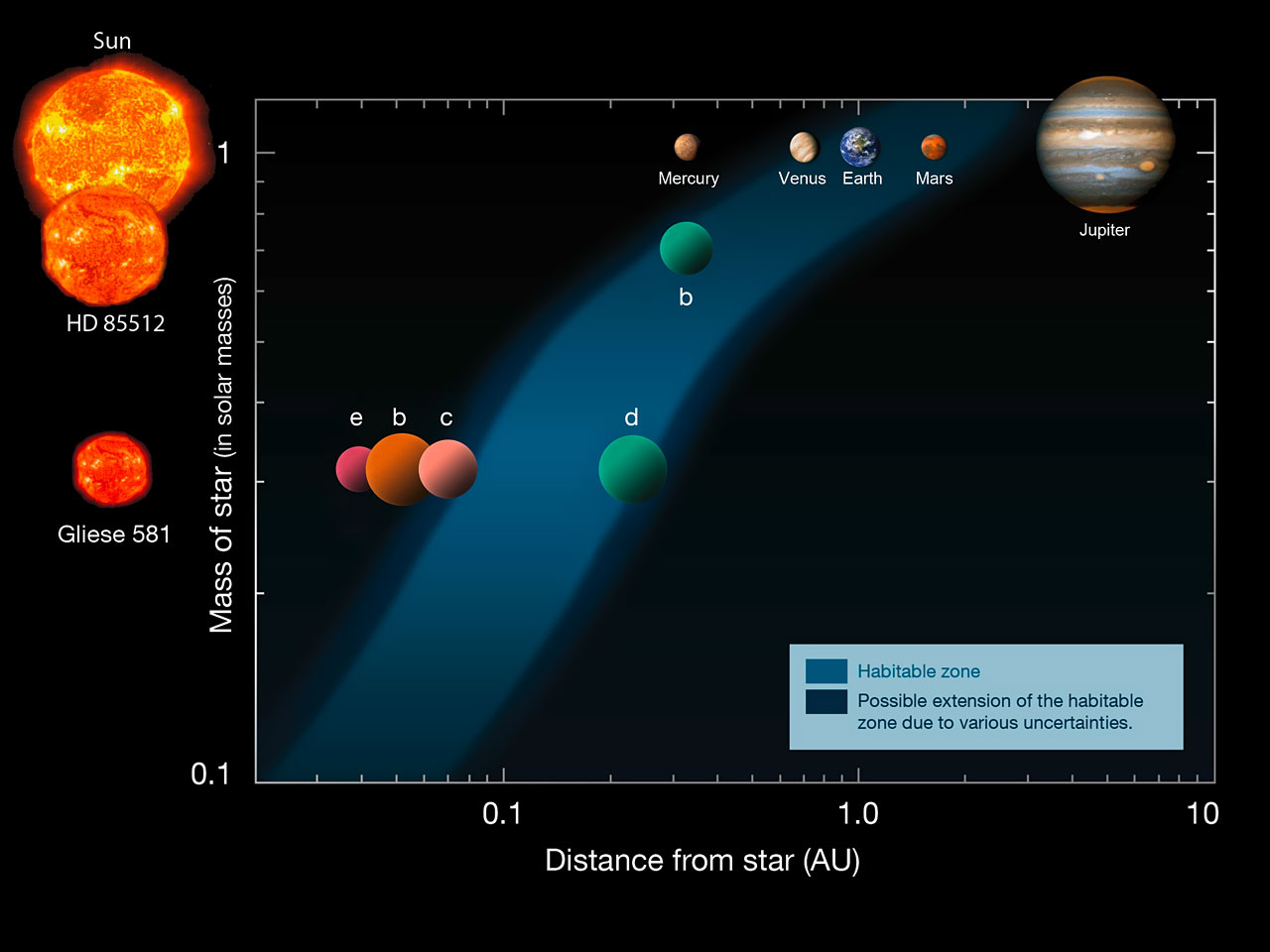
The diagram above shows the limits of the Habitable Zone which depend, notably, on the mass of the star and the distance of the Terrestrial body from the star. The Habitable Zone is defined as the cosmic zone where water can be found in its liquid form on the surface of the planet or moon. It seems, however that there is also a Liquid Methane Habitable Zone that is a cosmic zone around the star where liquid methane can be found on the surface of the planet or moon. Saturn's largest moon Titan may be in the "Liquid Methane Habitable Zone" or the "Liquid Ethane Habitable Zone".Image Source: ESO
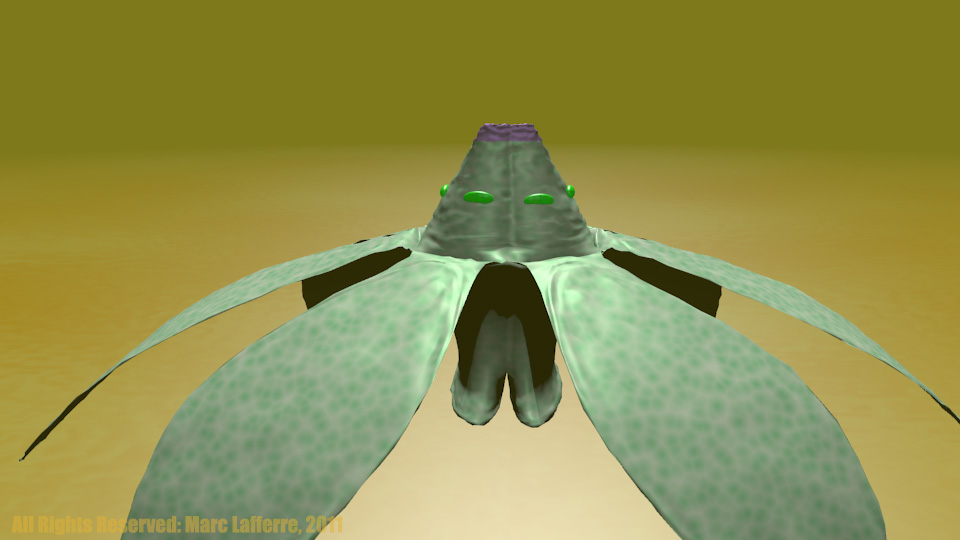
The artistic view above reveals a methane-based beast above Kraken Mare, the largest lake or sea identified in the high latitudes of the northern hemisphere of Titan. The flying beast called "Hexapterus" is an Hexapter that is a beast with six wings. The high pressure and the dense air near the surface appear ideal for a bird adapted to the harsh environment of the Orange Moon. The metabolism of the hypothetical beast may be closely related to a methane/ethane cycle involving methane, liquid ethane, hydrogen, acetylene and more complex hydrocarbons. © Artistic image: Marc Lafferre, 2011
- To get further information on that news, go to: http://www.astrobio.net/exclusive/4330/the-methane-habitable-zone.
October 15, 2011: A New Research Paper Suggests that Comets May Have Played a Key Role in the Formation of Titan's Atmosphere
Saturn's largest moon, Titan, is an uncommon moon in the Solar System due to its complex and enigmatic atmosphere. Most moons are devoid of any atmosphere. Only Titan and Triton, the moon of Neptune, present a significant atmosphere. That's surprising because large moons such as Ganymede or Callisto which are more massive than Titan have no atmosphere.
The Orange Moon, Titan, is covered with a deep, thick, dense and opaque atmosphere primarily made of molecular nitrogen, methane and argon. The Huygens probe which landed in the Shangri-La/Adiri area on January 14, 2005 recorded an atmospheric pressure of 1467 hPa on the surface. Thus, the atmospheric pressure on the Titanian ground is largely higher than the atmospheric pressure on Earth at sea level.
The opaque atmosphere of Titan presents some remarkable similarities with the atmosphere of the Blue Planet. Its atmosphere is mainly composed of molecular nitrogen and it harbours a dynamic weather with transient clouds or storms.
Yet, the environmental conditions on Titan are radically different from those of the Earth. The Huygens probe recorded a temperature of -179 degrees Celsius, -290 degrees Fahrenheit or 94 Kelvin on the soil of Saturn's largest moon and the composition of the soil is particularly exotic with low-density materials such as water ice, frozen carbon dioxide, tholins, carbon-made molecules, benzene and hydrocarbons such as methane and ethane.
The atmosphere of the Orange Moon undergoes seasons due to the relatively high inclination of the rotation axis to the normal of the orbital plane of the celestial body. A Titan year lasts almost 30 years and a season is equal to about seven Earth years. The observations from Cassini show that the weather on Titan is closely related to seasons.
During the Winter season in the northern hemisphere and the Summer season in the southern hemisphere, the cloud formations made of hydrocarbons (methane or ethane) were mostly concentrated in the high latitudes or the polar regions of the moon. Weather changes have been noticed since the arrival of the Spring season in the northern hemisphere and the arrival of the Autumn season in the southern hemisphere. Large cloud formations have developed in the low latitudes of the moon.
The origin and the persistence of Titan's atmosphere are not well understood. The moon is not very massive with a low mean density and a relatively low gravity. The weak gravity of the moon appears to be a negative factor for retaining its dense atmosphere. However, the low level of solar energy reaching the orbit of the Saturn system , which is equal to about 15 W/m², prevents most volatile molecules of Titan's atmosphere from escaping into outer space because they do not gather enough energy to reach the escape velocity.
The dense atmosphere of the Orange Moon may benefit from the right combination of gravity and solar energy, as opposed to Ganymede, for instance, which probably receives too much energy from the Sun (around 51 W/m²). Yet, the origin and the persistence of the Titanian atmosphere keep fueling multiple hypotheses including the hypothesis of cryovolcanism, geysers or internal sources (subsurface ocean...).
A new theory suggests that comets may have played a key role in the formation of Titan's atmosphere. The theory is presented in a Research paper entitled "Clues on the importance of comets in the origin and evolution of the atmospheres of Titan" by Josep M. Trigo Rodriguez, of the Institute of Space Sciences (CSIC-IEEC) in Barcelona, Spain and F. Javier Martin-Torres of the Center for Astrobiology in Madrid, Spain. The research paper was recently published in the journal Planetary and Space Science.
Josep M. Trigo Rodriguez and F. Javier Martin-Torres believe that the Titanian atmosphere may partly be the outcome of cometary impacts since comets bring a lot of volatile molecules such as water, molecular nitrogen, carbon dioxide or carbon monoxide. The atmosphere of Titan is reminiscent of the atmosphere of the Early Earth and it may represent a pre-biotic natural laboratory as the authors of the paper suggest.
Titan may hold the right ingredients for life to develop. The chemistry of carbon on Titan is very rich with an organic haze, a relatively high fraction of methane in the atmosphere, molecular nitrogen, tholins on the ground, clouds of ethane and methane as well as seas, lakes and rivers of hydrocarbons probably related to a meteorological cycle of methane and ethane.
Josep M. Trigo-Rodriguez pointed out: "Titan provides an extraordinary environment to better understand some of the chemical processes that led to the appearance of life on Earth." He added: "Titan's atmosphere is a natural laboratory that, in many aspects, seems to have a strong similitude with our current picture of the pre-biotic atmosphere of Earth."
There are atmospheric similarities between Titan and the Earth but there may be significant differences regarding the internal composition of the two bodies. The differences in composition may be closely related to the bombardment of meteorites and comets during the formation process of the Earth and Titan. The accretion process of planet Earth probably took shape from hot, oxygen-poor rocks or planetesimals found in the inner solar system. By contrast, the accretion process of Saturn's largest moon probably took shape from oxygen-rich rocks and other volatile molecules or cometesimals found in the outer solar system.
Josep M. Trigo-Rodriguez and F. Javier Martin-Torres advance the idea that the vital organic molecules in the Early Earth's atmosphere were first vaporized and expelled by solar winds. They returned toward the atmosphere of the Blue Planet about 4 billion years ago during the Late Heavy Bombardment (LHB) which corresponds to a cataclysmic rock storm.
During that particular period of the history of the Solar System, oxygen and volatile-rich compounds migrated from the outer solar system to the inner solar system. Our atmosphere and our ocean may result from that process.
Chris Mc Kay, a planetary scientist at NASA's Ames Research Center, develops the idea that the atmosphere of the Early Earth mostly results from meteorites or asteroids rather than comets. Comets may account for a small amount of the water, carbon dioxide and nitrogen content of the primitive atmosphere.
This hypothesis is based on a difference in the Deuterium/Hydrogen ratios of our oceans and in the Deuterium/Hydrogen ratios found in comets. Thus, asteroids harbouring water ice, frozen carbon dioxide and nitrogen may have had a greater influence on our atmosphere than the comets did. The water ocean of our planet may have been formed during the Late Heavy Bombardment.
Josep M. Trigo-Rodriguez underlines: "We think that asteroids and comets were key sources for water and organics." Titan and the Earth received the same kinds of asteroids, meteorites and comets but the particular environmental conditions led to different chemistries.
Josep M. Trigo Rodriguez and F. Javier Martin-Torres analyzed the reactions of hydrogen, carbon, nitrogen and oxygen isotopes with their environments on Saturn's largest moon and on the Blue Planet.
The atmospheres of both worlds may have been shaped by internal processes, outgassing and impacts from extra-terrestrial bodies. Those dynamic phenomena led to the formation of nitrogen-dominated atmospheres with similar isotopic ratios of hydrogen, carbon, nitrogen and oxygen.
The similarity between the atmosphere of Titan and the atmosphere of the Earth raises the astrobiological question as Josep M. Trigo-Rodriguez argued: "We see Titan as a natural oasis of remarkable astrobiological significance to understand the environment in which origin of life took place on Earth."..."It seems that a plausible scenario to build life consists of a dense atmosphere, where small particles like organic haze and meteoric metals could act as catalysts for the formation of more complex organic compounds from simple precursors such as carbon monoxide and methane, thus promoting increasing complexity."
The hypothesis that Titan's atmosphere appears to be a pre-biotic laboratory is strengthened by a 2007 experiment led by chemistry professor Margaret Tolbert and graduate student Melissa Trainer at the University of Colorado in Boulder who revealed that the early atmosphere of our planet would have had the same organic haze that stimulates formation of complex organic molecules on the Orange Moon.
One of the surprising characteristics of Titan's atmosphere is the relatively high concentration of methane because the Ultraviolet light tends to break down methane molecules over time. There must be an internal source such as a subsurface methane ocean that regularly replenishes the atmosphere with methane. Moreover, methane or ethane lakes are widespread in the polar regions of the moon which implies an internal source or a methane cycle.
Chris McKay said: "Earth's atmosphere is composed of compounds that persist over billions of years. However on Titan, all of the methane should have been destroyed by sunlight on a timescale of about 30 million years. There must be a source of methane re-supply."
F. Javier Martin-Torres would like to see a new lander in one of the lakes or seas of Titan's surface because it would be a perfect mission to better understand the dynamics, the origin and the nature of the liquid hydrocarbons found in the high latitudes or the polar areas of the Orange Moon. He insists: " We need a surface exploration with a lander-style mission."..."We're still missing the most important data."
If there is a stable methane cycle on Titan with permanently wet areas, one could envisage the possibility of a methane-based life because there is a solvent, the organic compounds and the ultraviolet light from the Sun to trigger complex reactions of organics. The area of Kraken Mare and Ligeia Mare in the north polar region may gather the right conditions for the development of a complex pre-biotic chemistry or for the development of an uncommon lifeform. There is no liquid water on the ground but there is liquid methane and ethane in the polar areas and this liquid may surprise us all.
Jean-Louis Berenguier of the French Astronomical Society GAPRA (Groupement d'Astronomie Populaire de la Région Antiboise) follows the hypothesis of an internal source which regularly replenishes the atmosphere with volatile gases such as molecular nitrogen and methane. Nevertheless, no clear topographic signs of cryovolcanism or geysers have been found so far from the Radar Mapper or from the VIMS instrument of the Cassini probe. There may be topographic fractures like those found in the south polar region of Enceladus but they have not been identified, yet.
Marc Lafferre of the GAPRA also follows the hypothesis of an internal source for the methane found in the atmosphere but he believes that this internal source generates very weak flows of methane and molecular nitrogen over time. Most of the methane found in the seas, lakes and clouds may mostly result from a natural process of evaporation and precipitation similar to the water cycle taking shape on Earth, as he points out. The ultraviolet light tends to destroy or break up methane molecules but they recombine to form new molecules including new methane molecules, hence participating in the methane cycle.
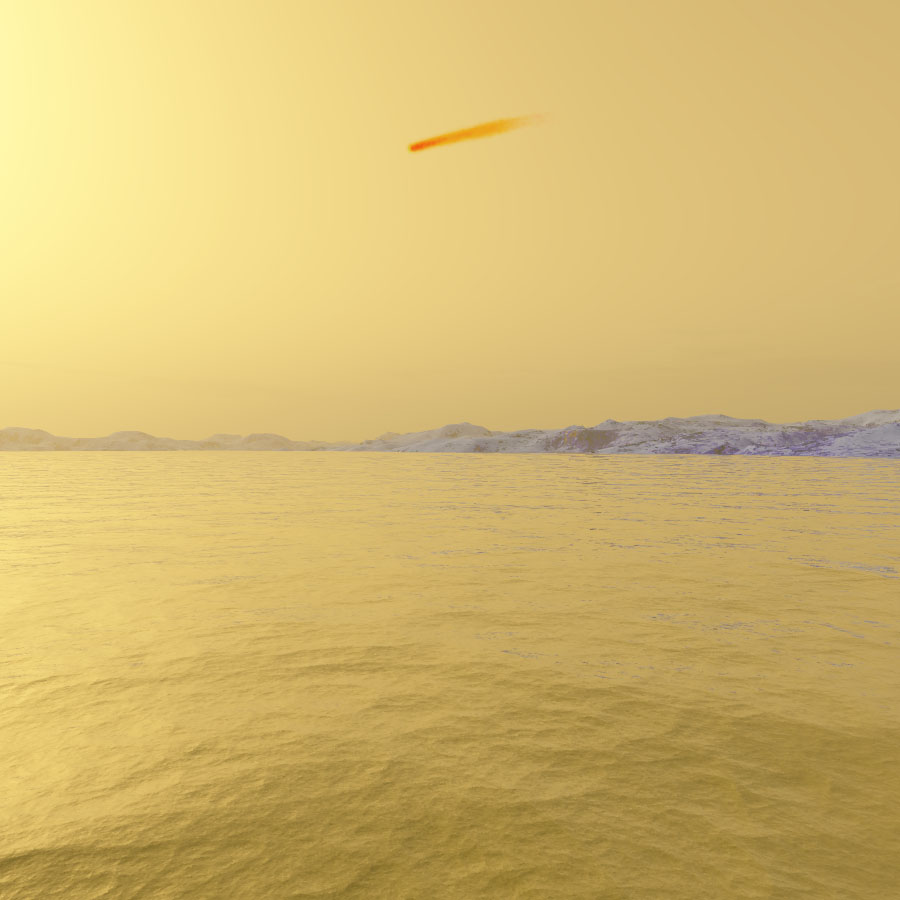 |
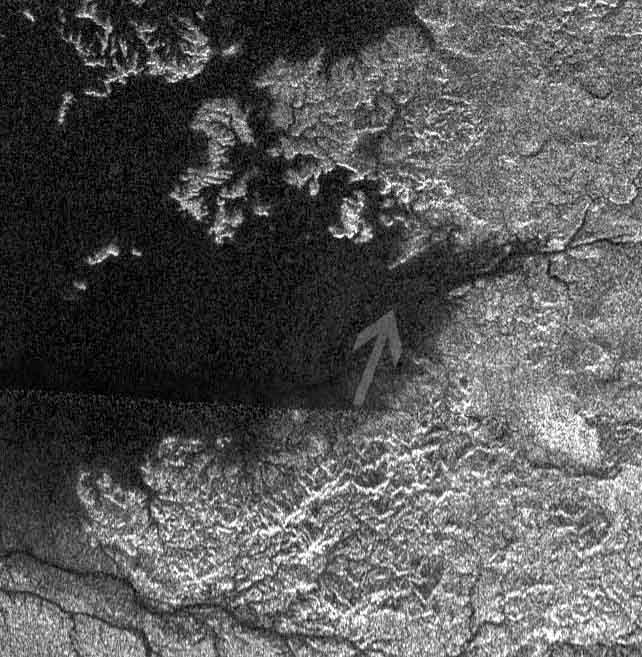 |
The computer-generated image shown in the upper
part of the table corresponds to an artistic view of the remnant
of a comet running through Titan's atmosphere in the north polar
area, in the region of Ligeia Mare. Radar Image Credit: NASA/JPL |
- To get further information on that news, go to: http://www.astrobio.net/exclusive/4273/the-hazy-history-of-titan’s-air.
October 6, 2011: The Diversity of Titan's Landscape is Revealed by a New Colour Map Created by a Team Led by the University of Nantes
A new global map of Titan, based on a set of images gathered over six years from the Cassini probe and generated by a team led by the University of Nantes and Stéphane Le Mouélic has been presented on October 4th, 2011 at the EPSC-DPS Joint Meeting 2011 in Nantes, France.
The EPSC-DPS Joint Meeting 2011 is the outcome of the first cooperation between the European Planetary Science Congress (EPSC) organised by the Europlanet Research Infrastructure and the Division for Planetary Sciences of the American Astronomical Society.
Saturn's largest moon has a thick, dense and opaque atmosphere. Therefore, a few specific infrared wavelengths are needed to remove the veil of Titan's atmosphere and discern surface details from outer space.
The deep atmosphere of the Orange Moon is made of haze and transient clouds. Clouds can appear bright and opaque in the near-infrared spectrum. However, very few clouds have been observed in the equatorial or tropical regions. Transient cirrus-like clouds have been identified at mid-latitudes but recently, large cloud systems have developed in the low latitudes.
The Seif Dunes or parallel dune fields extending over long distances which are widespread in the dark areas of the low latitudes demonstrate that the landscape or the topography is shaped by meteorological phenomena such as rainfall, snowfall or prevailing winds throughout erosional processes.
Generating a global mosaic of Titan's surface turns out to be particularly complicated because there are differences in spatial resolution between the near-infrared views obtained by the Visual and Infrared Mapping Spectrometer of the Cassini probe since the arrival of the spacecraft in the Saturn System in 2004. Moreover, the viewing angle will vary in each flyby of Titan.
The global colour map was based on images acquired during the first seventy flybys. The researchers had to perform corrections in the images due to differences in the illuminating conditions. They also had to remove atmospheric distortions by filtering each image on a pixel-by-pixel basis.
Surface details are sometimes hard to interpret but the combination of near-infrared data and radar data allows scientists to better analyse the landscape features such as the dark "Ontario Lacus" in the high latitudes of the southern hemisphere. Thus, Ontario Lacus appears to be the largest body of liquid hydrocarbons in the south polar region.
Stéphane Le Mouélic pointed out: "As Cassini is orbiting Saturn and not Titan, we can observe Titan only once a month on average. The surface of Titan is therefore revealed year after year, as pieces of the puzzle are progressively put together. Deriving a final map with no seams is challenging due to the effects of the atmosphere -clouds, mist etc.- and due to the changing geometries of observation between each flyby."
The global mosaic is not uniform in terms of spatial resolution. Surface details can be as low as 500 meters per pixel in some places as Stéphane Le Mouélic said: "We have created the maps using low resolution images as a background with the high resolution data on top. In the few opportunities where we have VIMS imagery from the closest approach, we can show details as low as 500 metres per pixel. An exemple of this is from the 47th flyby, which allowed the observation of the site where the Huygens descent module landed. This observation is a key one as it might help us to bridge the gap between the ground truth provided by Huygens, and ongoing global mapping from orbit, which will continue up to 2017."
The Huygens probe landed in the area of the bright Adiri and the dark Shangri-La. The images captured from the probe during the atmospheric descent on January 14, 2005 revealed that the bright hills of Adiri were composed of fractures or drainage channels suggesting that storms or rainfalls of methane or ethane sometimes occur. The aerial views also showed the color contrast between the bright hills and the dark, brownish or orange terrain near Adiri.
The near-infrared and radar data of the region obtained from the Cassini spacecraft bring complementary information to study this area. The radar images clearly show that the dark Shangri-La is dominated by Seif Dunes or linear and parallel dunes shaped by prevailing winds.
The images from the Huygens probe have not unveiled Seif dunes and the Huygens module may have landed onto a riverbed because the view from the surface shows pebbles or eroded stones near the probe and a rupture in the distribution of the stones a few meters from the module.
Due to the orbital configuration of Saturn's largest moon, some polar areas can be plunged into darkness during the winter period. Thus, the north polar region experienced the winter season for about seven years until August 2009 and a portion of the area was not covered by sunlight preventing scientists from obtaining optical images or near-infrared views of the polar area.
The lakes of the north polar region are now coming into view as the spring season is advancing in the north polar region or the northern hemisphere. Surface details can now be identified in the north polar region in the near-infrared spectrum. The views may bring significant information on the composition of the lakes, seas and rivers of the high latitudes of the northern hemisphere.
Stéphane Le Mouélic advanced: "Lakes in Titan's northern hemisphere were first discovered by the RADAR instrument in 2006, appearing as completely smooth areas. However, we had to wait up to June 2010 to obtain the first infrared images of the northern lakes, emerging progressively from the northern winter darkness."..."The infrared observations provide the additional opportunity to investigate the composition of the liquids within the lakes area. Liquid ethane has already been identified by this means."
The liquid bodies appear to be concentrated in the high latitudes of the Orange Moon. But the pools of liquids may be quite volatile with strong evaporation processes. Will the northern lakes and seas strongly diminish in size since the summer season is approaching in the area ?
If Kraken Mare or Ligeia Mare remain quite stable over time, they may represent a perfect place for future exobiological exploration because a potential methane-based lifeform may have had enough time to develop in the cryogenic solvent of those seas. The area is also an interesting location for studying the chemistry of hydrocarbons or even the prebiotic chemistry with large concentrations of carbon-made molecules and an atmosphere dominated by methane and nitrogen.
The four disks above reveal the new mosaic of Titan's surface proposed by a team led by the University of Nantes and Stéphane Le Mouélic. In the upper part of the view, one can clearly identify the area of the dark "H" of Fensal and Aztlan located in the low latitudes of the Orange Moon. To the left of Fensal/Aztlan region, one can observe the bright Xanadu, located between the dark Shangri-La and the dark Fensal/Aztlan. The bright Adiri can be clearly observed as well in the lower right view. Image Credit: JPL/NASA/University of Arizona/CNRS/LPGNantes
The composite view above shows several views of a portion of Titan's northern seas. The right portion, showing the north polar area with artificial colors, is the outcome of a radar image obtained from the Cassini probe. Ligeia Mare appars in the middle of the View. Kraken Mare and Punga Mare can be partially seen above Ligeia Mare. The two VIMS images, from the left, reveal the same area. Image Credit: JPL/NASA/University of Arizona/CNRS/LPGNantes
The image above shows the region of the Huygens landing site with a radar background obtained with the radar mapper of the Cassini spacecraft. The image of Titan's soil taken by the Huygens probe on January 14, 2005 is incorporated into the map to precisely indicate the landing site of the Huygens module. VIMS portions made of artificial colors are also inserted into the map to reveal surface details. Image Credit: JPL/NASA/University of Arizona/CNRS/LPGNantes
- To get further information on that news, go to: http://www.europlanet-eu.org/outreach/index.php?option=com_content&task=view&id=353&Itemid=41.
August 20, 2011: The Shape of a Giant Arrow-Shaped Cloud Identified in Titan's Tropical Zone in September 2010 May Be Explained By Atmospheric Waves
Saturn's largest moon, Titan, appears to be the only moon in the Solar System covered by a significant atmosphere. The orange, opaque atmosphere of Titan appears roughly uniform from the camera of the Cassini spacecraft, in the visible spectrum. One can notice, however, that a brightness dichotomy can be observed between the northern hemisphere and the southern hemisphere depending on seasonal phenomena. The north polar region may also appear darker than the Tropical region during the Winter period for instance.
In the opaque and relatively uniform atmosphere of Titan, dynamic clouds can be regularly observed. The dynamics, the shape and the concentration of cloud systems appear to be intimately linked to seasonal factors.
Each season on this moon lasts approximately 7 Terrestrial years and a year on Titan lasts about 29.5 Earth years. The Winter season in the northern hemisphere and the Summer season in the southern hemisphere came to an end in August 2009. The northern hemisphere is now experiencing the Spring season whereas the southern hemisphere is experiencing the Autumn season.
The complex weather system of the "Orange Moon" is closely related to seasonal factors as the near-infrared observations from the Cassini probe show. Near-infrared observations of the south polar region and the north polar region have shown that cloud formations were mostly concentrated in the polar regions during the Winter period in the northern hemisphere and the Summer period in the southern hemisphere.
During that period, transient cirrus-like clouds have been identified at mid-latitudes. Nevertheless, the Tropical region appeared particularly dry during that period comparatively to the polar regions where large cloud systems, lakes, seas and rivers have been clearly observed via near-infrared and radar data.
Yet, since the beginning of the Spring period in the northern hemisphere and the Autumn season in the southern hemisphere, the meteorology or the weather seems to be significantly evolving within the Tropical zone as recent near-infrared and radar data have revealed.
A near-infrared image of Titan's disk, obtained with the narrow-angle camera of the Cassini spacecraft on September 27, 2010 reveals a huge arrow-shaped cloud formation in the Tropical area. This bright atmospheric arrow corresponds to a storm which measures, at least, about 1,200 kilometers or 750 miles in length east-to-west and the two parts of the arrow forming the wings orientated from the easternmost point to the northwest and the southwest are each approximately 1,500 kilometers or 930 miles long.
Another view consisting of near-infrared and visible spectrum data, taken on October 18, 2010 from the narrow-angle camera of the Cassini spacecraft unveils an unusual cloud system in the low latitudes of Saturn's largest moon. Massive and elongated clouds can be noticed within the Tropics. This observation suggests a seasonal change in the Equatorial and Tropical zone where cloud systems had been quasi-absent or particularly scarce before the Equinox of August 2009 during the Winter period in the northern hemisphere and the Summer period in the southern hemisphere.
The radar images have shown that the optically-dark areas of the low latitudes are dominated by Seif Dunes or parallel dune fields which extend over long distances. Drainage channels have been identified in the low latitudes but they may be dry and no clear sign of lake or sea has been found within the Tropics as opposed to the polar regions where lakes, seas and rivers have been clearly identified on the basis of the Radar Mapper and the "Visual and Infrared Mapping Spectrometer" of the Cassini spacecraft.
Those recent observations of clouds within the Tropics demonstrate the dynamics of Titan's complex climate and meteorology. Those clouds may bring a lot of precipitation in regions like the bright Xanadu, the bright Adiri and the dark Belet. Changes in appearance in Adiri have been identified on the basis of images of the area acquired on May 13, 2007 and on January 15, 2011. Unusual bright spots in Adiri appear in the January 15, 2011 image acquired in the near-infrared spectrum.
They may result from heavy methane or ethane rain. These brightened patches may correspond to a terrain which has been washed clean by the rain. They may also reveal a low-lying fog or clouds in areas where the amount of moisture is particularly high. As the Spring season in the northern hemisphere and the Autumn season in the southern hemisphere advance, large cloud systems bringing precipitations may become more and more frequent in the low latitudes of the moon due to a higher solar illumination.
The dynamics of clouds on Titan is a subject of debate and research and the shape of the arrow-shaped cloud observed on September 27, 2010 has drawn a lot of attention on the part of scientists. A recent research based on a three-dimensional global climate model demonstrates how planetary-scale atmospheric waves can engender that kind of clouds. The study led by Jonathan L. Mitchell, UCLA assistant professor of earth and space sciences and of atmospheric and oceanic sciences and involving Maté Adamkovics, a project scientist with UC Berkeley's astronomy department , Rodrigo Caballero, a professor of meteorology at Sweden's Stockholm University and Elizabeth P. Turtle, a research scientist with Johns Hopkins University's Applied Physics Laboratory appeared in the online edition of the journal Nature Geoscience on August 14, 2011.
The surprising geometry of the arrow-shaped cloud made of linear edges could be explained by large-scale atmospheric waves that we can encounter in our atmosphere in the form of Rossby Waves. Jonathan L. Mitchell pointed out: "The atmospheric waves are somewhat like the natural, resonant vibration of a wine glass."..." Individual clouds might 'ring the bell', so to speak, and once the ringing starts, the clouds have to respond to that vibration."
The vibration is in fact like the impact of a raindrop into a pond or the impact of a tectonic movement of an oceanic plate which triggers a tsunami or giant linear waves that invade the land.
This arrow-shaped cloud may have brought heavy rainfalls or intense precipitation in the areas of the bright Adiri and the dark Belet as radar images suggest. Unusual bright patches were observed a few days later in Adiri, as we've already said. Scientists believe that the precipitation generated by that kind of atmospheric waves can represent more than 20 times the average seasonal rainfall on Titan.
Regular processes of precipitation and evaporation in the Tropical area may account for the Seif Dunes which dominate the dark areas of the low latitudes of the Orange Moon. Rains of methane and ethane may strongly erode the landscape. Jonathan L. Mitchell characterized the climate of the Opaque Moon as "All-tropics" since the storms observed here, can take shape anywhere on Titan.
He advanced: "Our new results demonstrate the power of this analogy, not only for general features of Titan's climate but also for individual storms." This analysis allows scientists to make predictions on the dynamics or shape of future cloud systems.
Jonathan L. Mitchell argued: "Titan's all-tropics climate gives us the opportunity to study tropical weather in a simpler setting than on Earth."..."Our hope is that this may help us understand Earth's weather in a changing climate."
The climate of Titan appears simpler than that of the Earth because the bodies of liquids are concentrated, only, in the high latitudes or the polar regions of the moon. The surface of Titan appears relatively uniform although a brightness contrast can be found between the dark areas of the low latitudes and the bright areas which dominate the landscape on the globe. As a result, the methane or ethane cycle is easier to study in the Opaque atmosphere of Titan than the water cycle in the atmosphere of our planet.
Jonathan L. Mitchell noted: "Titan is like Earth's strange sibling - the only other rocky body in the solar system that currently experiences rain." Similarities can be found between the atmosphere of the Earth and the atmosphere of Titan. Each atmosphere is mostly composed of molecular nitrogen. Methane is the second most abundant constituent of Titan's atmosphere whereas oxygen is the second most abundant constituent of the Terrestrial atmosphere. Methane plays the same role as Terrestrial water on Titan with a complex methane cycle between the ground, the underground and the atmosphere. One can find lakes, seas, rivers, clouds, rainfall and evaporation on Titan.
The atmosphere of the Early Earth may have had large amounts of methane and very little oxygen. Methane, which is a strong greenhouse gas, may have played a major role in warming Earth's atmosphere. The atmosphere of Titan generates weak greenhouse effects but water is completely frozen on Titan due to the low amount of energy reaching Saturn's largest moon.
Jonathan L. Mitchell advanced: "Therefore, by studying Titan's modern climate, we may gain new insights about the way the early Earth's climate was." Titan's atmosphere may appear as a prebiotic laboratory unveiling an atmosphere resembling the atmosphere of the Early Earth. Will the large cloud systems observed in the low latitudes of Titan become more and more frequent in the Tropics of the moon in this new season? The near-infrared data gathered from the Cassini spacecraft in the coming months and years will probably answer that question and provide a better idea of the complex weather system on the Orange Moon.
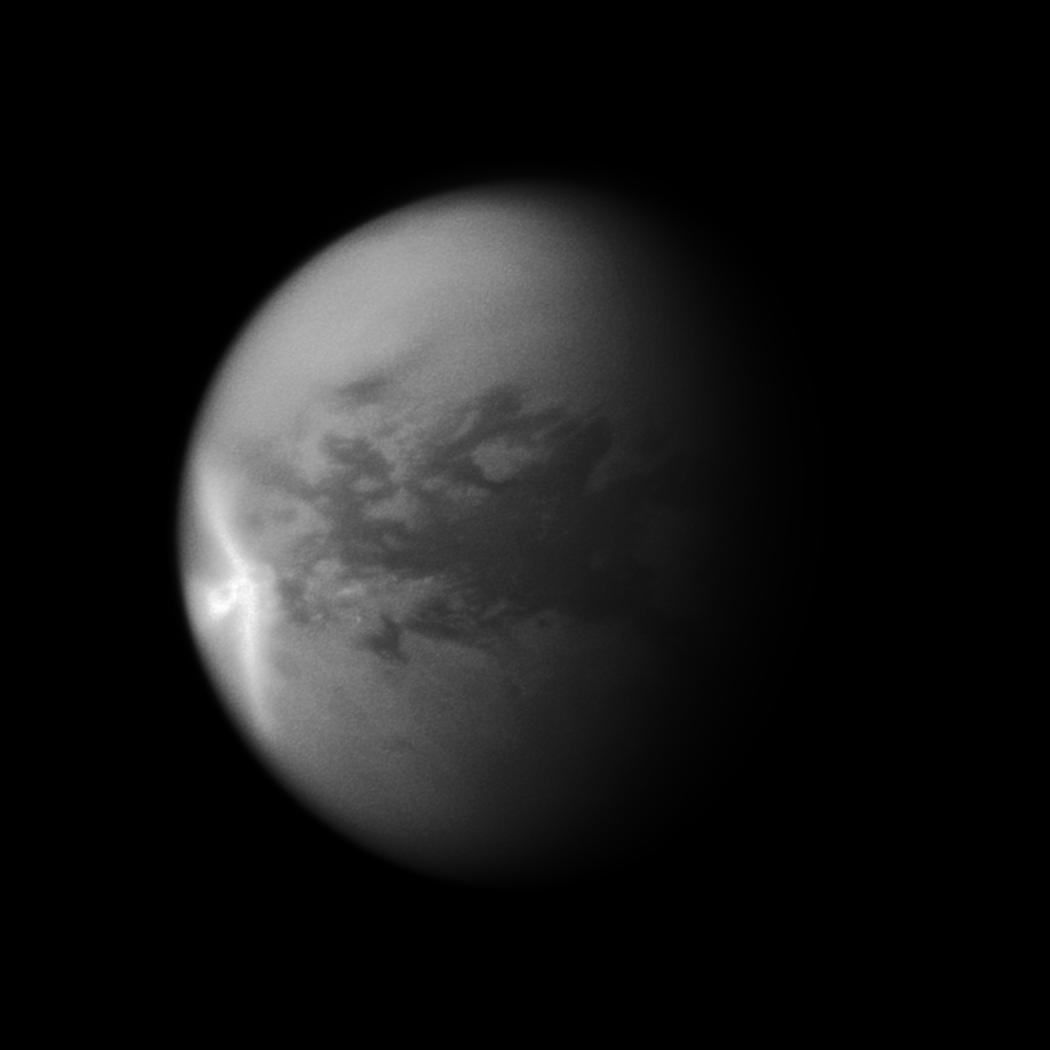
The near-infrared image of the disk of Titan, above, reveals the arrow-shaped cloud observed from the narrow-angle camera of the Cassini probe on September 27, 2010. This storm may have engendered a lot of precipitation on the ground in the form of methane or ethane rain. The surprising shape of the arrow-shaped cloud may be related to large-scale atmospheric waves. Image Credit: NASA/JPL/SSI
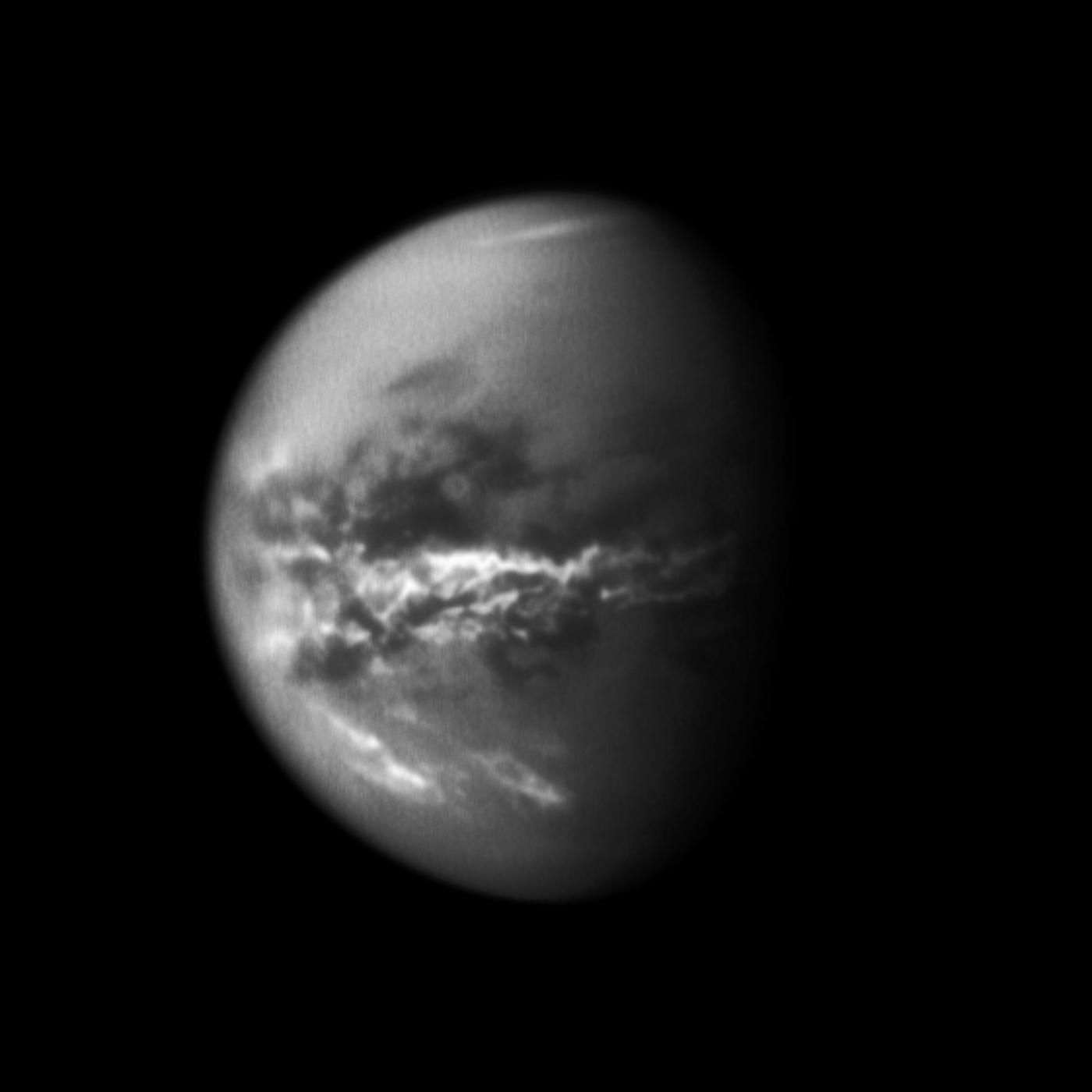
The composite image of Titan's disk above reveals a surprising concentration of elongated clouds in the low latitudes or the Tropics of the moon on October 18, 2010, a few days after the observation of the arrow-shaped cloud. The photos used to obtain the view above were obtained with the narrow-angle camera of the Cassini probe. As the Spring in the northern hemisphere and the Autumn season in the southern hemisphere advance, the clouds may become more and more present in the low latitudes due to a higher solar illumination. Image Credit: NASA/JPL/SSI
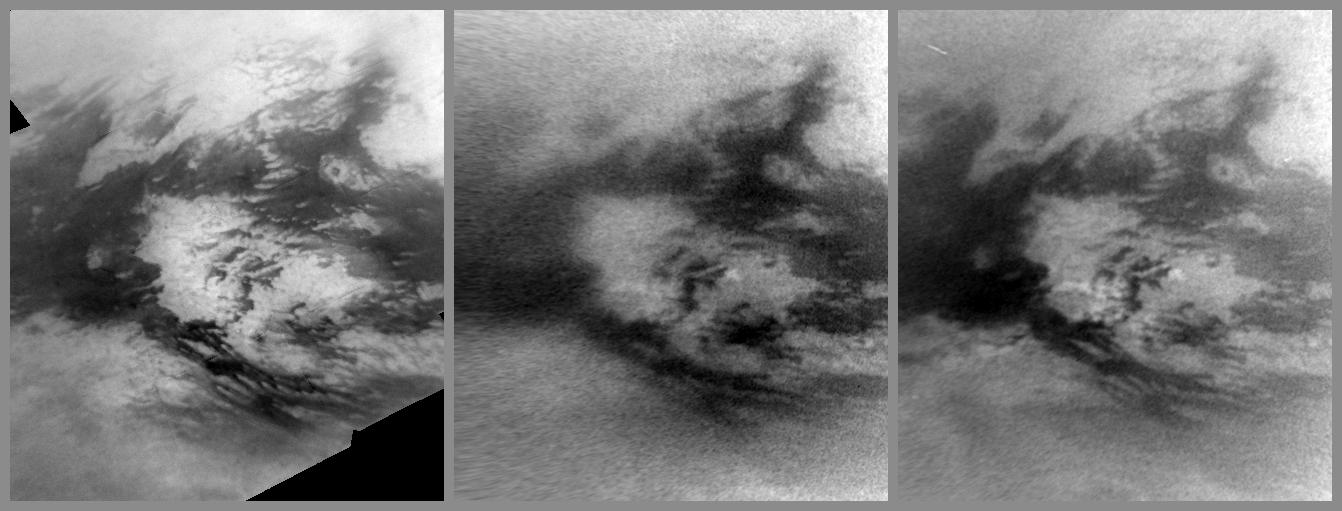
The three near-infrared images above reveal the bright Adiri and the dark Belet at different times to show landscape changes related to the storms which occured in late 2010. The views were obtained with the narrow-angle camera of the Cassini probe. The left view was acquired on May 13, 2007. The other views were captured on January 15, 2011, 15 hours apart. Bright patches appear in the bright Adiri on May 13, 2007. They may correspond to a low-altitude fog or a terrain which has been washed by methane rain. Image Credit: NASA/JPL/SSI

The mosaic above shows the view of the surface of Titan, obtained from the Huygens probe on January 14, 2005, in the left part. The image was acquired in the equatorial or tropical region of the bright Adiri and the dark Shangri-La. The right view represents a dried-up river on Earth, obtained on August 10, 2011, in the village of Concorès (Département du Lot, France). This confrontation of images allows us to notice similarities between the surface of Titan and this Terrestrial dried-up river. Erosion sculpts the landscape on Earth and on Titan. The Huygens probe may have landed on a dried-up river since pebbles or strongly eroded stones appear in the foreground. The recent observation of large cloud systems in the low latitudes suggests that the drainage channels observed in the Adiri and Shangri La regions are seasonally refueled by methane or ethane rain. Assembling Work Credit: Marc Lafferre, 2011.
- To get further information on that news, go to: http://newsroom.ucla.edu/portal/ucla/what-caused-a-giant-arrow-shaped-213463.aspx and http://www.space.com/12640-saturn-moon-titan-weird-cloud-explained.html.
June 4, 2011: New Clues Strengthen the Hypothesis for an Underground Ocean in Saturn's Largest Moon
The Orange Moon Titan appears to be an exotic world with a complex atmosphere, a complex climate, a complex meteorology and a varied landscape. A new study unveils new clues suggesting that the internal structure may be complex as well with different layers incorporating a subsurface ocean.
Planetary scientists believe that several moons in the Solar System may harbor an underground ocean. Europa, a moon of Jupiter, and Enceladus, a small, icy moon of Saturn appear to be very strong candidates for the hypothesis of an internal ocean.
Thanks to the observations made from the Cassini spacecraft, we know, now, that there are topographic fractures known as "Tiger Stripes" in the south polar region of Enceladus and those Tiger Stripes correspond to the source of the sprays of water ice identified from the Cassini probe.
If there is cryovolcanism and if there are geysers of water ice in the south polar region of Enceladus, one may reasonably infer that there is a subsurface ocean or a subsurface sea beneath the icy crust of the bright Enceladus. Even a small moon evolving very far from the Sun in a cold environment can harbor hot sources and a strong internal activity.
Europa is believed to harbor an underground ocean because of its fractured landscape. A series of parallel, topographic fractures can be observed all over the surface. They may result from frictions related to the instability of a liquid layer beneath the icy crust.
The tidal effects generated by Jupiter, Io, Ganymede, Callisto and the other moons may play a key role for the formation or the dynamics of the internal ocean and the internal activity. The tidal effects in the Saturn System may also play a key role for the formation of the geysers on Enceladus.
Triton, Pluto and Charon appear to be strong candidates, as well, for the presence of cryovolcanism and an internal ocean. Geysers or "Black Smokers" have already been identified on Triton which implies hot sources below the surface with liquid pockets or liquid layers. The tidal forces of Neptune and the other moons may also have a strong effect on the dynamics in the interior of the moon and on the dynamics of the potential ocean.
Pluto and Charon which are moving very close to each other may generate a strong energy triggering cryovolcanism on those celestial bodies. And cryovolcanoes imply hot sources or liquid layers beneath the icy crust.
Regarding Titan, several clues are consistent with the hypothesis of an underground ocean. The Orange Moon is covered with a deep, thick and dense atmosphere primarily made of nitrogen. This atmosphere is also composed of a significant amount of methane. Thanks to the VIMS and Radar observations from the Cassini spacecraft, one knows, now, that there is a methane cycle between the ground and the atmosphere.
This methane cycle resembles the water cycle that we encounter on the "Blue Planet". There are lakes, seas and rivers of methane and ethane on Titan and there are cloud formations which are closely related to season changes. Like on Earth, evaporation and precipitation processes occur on the Opaque Moon.
The gas blanket of Titan is intriguing because most moons in the Solar System are devoid of any significant atmosphere. The largest moon of Jupiter, for instance, has no atmosphere. Triton is the only other moon known to have a significant atmosphere.
The origin of the atmosphere of Titan is not clearly understood. Most scientists advance that the atmosphere took shape thanks to a relatively high gravity and to a low level of energy at the distance of the Saturn System from the Sun. In other words, there is the right combination of gravity and temperature which allows the gas particles to be retained by Saturn's largest moon.
Yet, scientists are astonished by the fact that methane appears in larges quantities in the atmosphere of Titan because methane tends to have a lifespan of about 10 million years due to the action of ultraviolet light. To explain that paradox, some specialists advance the idea that there may be internal sources of methane. Methane may come from the underground via cryovolcanoes or geysers.
Is there an internal ocean of methane or hydrocarbons ? Are there internal sources of liquid ammonia or nitrogen ? The specialist of Titan, Jonathan Lunine had developed the idea of a potential water/ammonia ocean beneath the crust of the Orange Moon.
The near-infrared views and the radar images acquired from the Cassini probe have allowed scientists to identify a few surface features which may correspond to cryovolcanoes. One can mention, notably, Hotei Arcus or Hotei Regio, Ganesa Macula or Elpis Macula.
Some radar images obtained from the Radar Mapper of the Cassini spacecraft have revealed that a number of prominent topographic features had shifted from their expected positions by up to 19 miles or 30 kilometers.
That implies that the outer crust of Titan is relatively unstable, that there are tectonic movements, Titan quakes and that the internal layer beneath the crust is unstable as well. Therefore, there may be an underground ocean in Saturn's largest moon.
A new study related to orbital parameters reinforces the hypothesis of the underground ocean. The analysis which was led by Rose-Marie Baland, a planetary scientist at the Royal Observatory of Belgium in Brussels in collaboration with Tim Van Hoolst, Marie Yseboodt and Ozgur Karatekin shows that the surprising obliquity of Titan may be consistent with the presence of a subsurface ocean. The study is available online at http://arxiv.org/abs/1104.2741.
The inclination of the rotation axis to the normal of the orbital plane is around 27 degrees for Titan. The obliquity to the normal of the orbital plane of Titan around Saturn is about 0.3 degrees which seems high, given the estimate of the movement of inertia of the Opaque Moon.
This outcome could be explained by a denser material in the upper part of the sphere than at its center. This hypothetical configuration is not in line with basic physics. Thus, Rose-Marie Baland pointed out: "This is in contradiction with all we know about other planets and satellites and planetary formation processes."
Rose-Marie Baland and her colleagues envisage another possibility involving a liquid layer in the interior to account for the orbital or planetary parameters. They propose a new Cassini state model incorporating a liquid water ocean beneath an ice shell.
In their model, Titan, whose mean density is approximately 1.88 g/cm3, is a differentiated body with multiple layers of materials. In that hypothetical configuration, there is an icy, rocky core. Above it, there is an icy mantle. The third layer from the center of the moon represents a liquid water ocean. An icy shell floats on it.
The estimate for the thickness of the liquid ocean ranges from 3 miles or 5 kilometers to 265 miles or 425 km. The estimate for the thickness of the icy shell ranges from 90 miles or 150 km to 125 miles or 200 km.
Rose-Marie Baland argued: "We found it very exciting to use some measurements that seem in contradiction and to try to reconcile them."..."It was like putting together pieces of a puzzle."
The surprising inclination of the rotation axis of Titan as well as its orbit may also be explained by exogenic phenomena or disturbances such as the impact of a comet or asteroid.
Rose-Marie Baland insisted: "Our analysis strengthens the possibility that Titan has a subsurface ocean, but it does not prove it undoubtedly."..."So there is still work to do."
Rose-Marie Baland and her collaborators intend to apply their method to assess the potential for a subsurface ocean in Io, Europa, Ganymede and Callisto. Rose-Marie Baland advanced: "The measurements of the obliquity of Europe or Ganymede could bring additional evidence for subsurface liquid layers."
The surface of Titan is varied with different materials including hydrocarbons, tholins and bright materials (water ice...). The hypothetical underground ocean could be made of one of these materials. Some scientists favour the hypothesis of a subsurface ocean composed of liquid water and liquid ammonia. But, the liquid layer could also be made of liquid methane or liquid ethane and in that case, this liquid layer could be a major source of the atmospheric methane.
The geysers or cryovolcanoes would spew methane or ethane gas as well as mixtures of liquid hydrocarbons and water. The drainage channels on bright hills observed by the Huygens probe during its descent through Titan's atmosphere on January 14th, 2005, could be the outcome of cryovolcanism but it could also be related to methane rain.
Astrobiologists are wondering whether the liquid bodies observed by the Radar Mapper in Titan's polar regions could host a methane-based life. The lakes or seas represent a solvent for any life and methane and ethane are made of carbon which is a key ingredient of life as we know it.
The hypothesis of a subsurface ocean composed of liquid hydrocarbons such as liquid methane strengthens the hypothesis of a methane-based life. A subsurface ocean consisting of liquid water could potentially host a more common life involving carbon and water molecules.
Rose-Marie Baland pointed out: "Astrobiologists do not really know yet what are the necessary conditions for life to emerge, but it seems that the presence of water is a requirement."
The debate on the nature of the hypothetical subsurface ocean continues. The water particles erupting from the south pole of Enceladus demonstrate that subsurface seas or lakes are possible in the cold environment of the Saturn System. Likewise, the high concentration of methane in the atmosphere of Titan and its lakes, seas and rivers show that internal sources of liquid methane and ethane are possible.
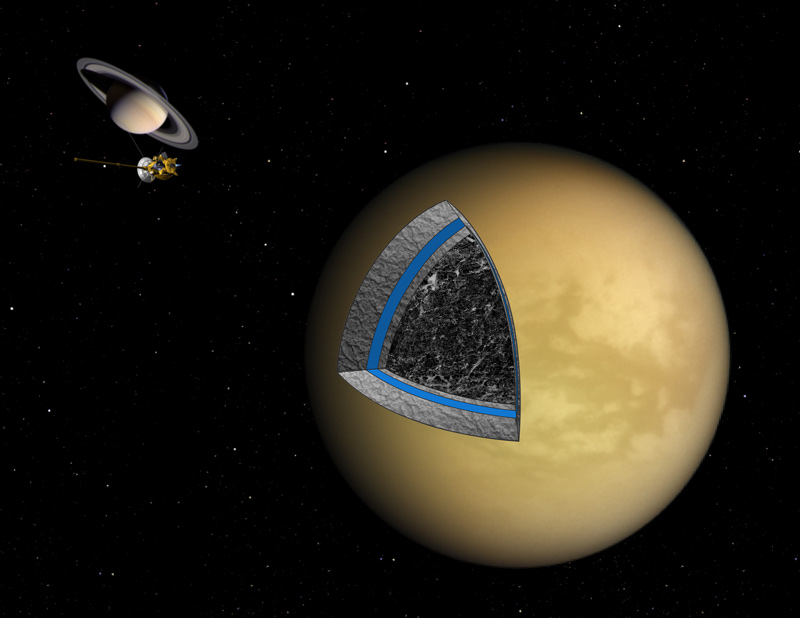
The artistic illustration above shows the hypothetical internal structure of Saturn's largest moon Titan incorporating a thin layer of liquids. The core is thought to be composed of a mix of rock and water ice. The internal ocean is believed to be located between two layers of ice. The presumed ocean may be composed of mixtures of water and ammonia or it may consist of mixtures of methane and ethane. Image credit: NASA/JPL
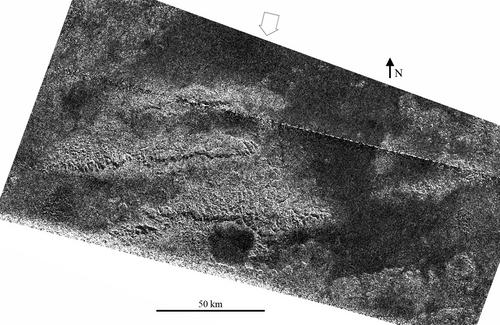
The radar portion above, centered at 2 degrees south latitude and 127 degrees west longitude in the area of the bright Xanadu, reveals three parallel ridges in the landscape of the Orange Moon. The view was obtained from the Cassini spacecraft on May 12, 2008. The mountain chains suggest the action of tectonic forces. That implies that the crust in unstable. A liquid layer beneath the crust may account for that kind of geological phenomenon. Image credit: NASA/JPL
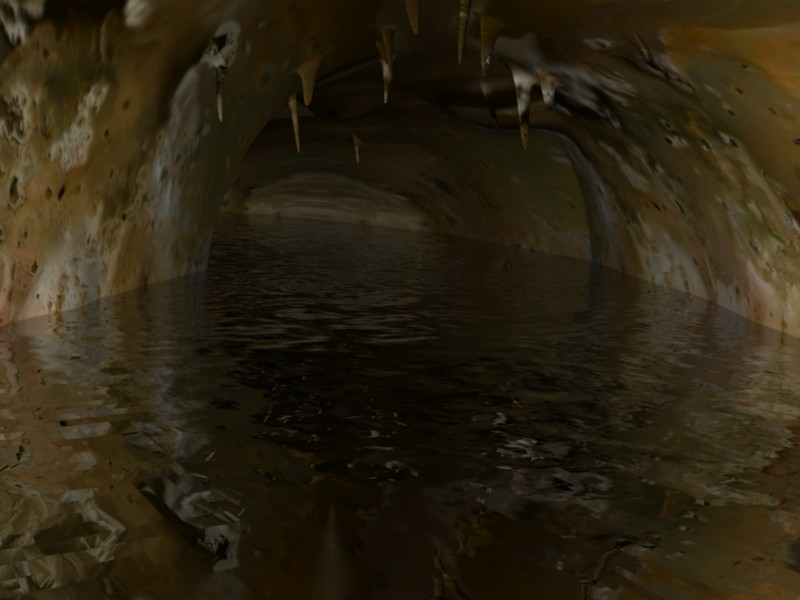
The artistic view above unveils a cave with an underground river in the north polar region of Titan in the area of Kraken Mare and Mayda Insula. The liquid is thought to be composed of mixtures of methane and ethane. Exotic Stalagtites, similar to those found in the caves on Earth can be noticed. The caves take shape in a karstic terrain. The liquid hydrocarbons tend to infiltrate into the soil that is rich in water ice and hydrocarbons or organics (tholins...). Image credit: Marc Lafferre, 2011
- To get further information on that news, go to: http://www.astrobio.net/exclusive/3949/a-water-ocean-on-titan or http://www.space.com/11550-saturn-moon-titan-underground-ocean.html.
May 10, 2011: A New Study Reveals that the Altitude of the Detached Haze Layer of Titan's Upper Atmosphere Has Strongly Diminished Between Observations in 2006 and in 2010
The in-depth exploration of Saturn's largest moon, Titan, made possible by the Cassini spacecraft and the Huygens probe reveals that the Orange Moon is a dynamic world with a dynamic and complex atmosphere.
Most of the moons in the Solar System are devoid of any atmosphere because they are not massive enough or cold enough to retain a gas layer. Thus, the moons of Jupiter, Callisto or Ganymede are not covered by an atmosphere even if their size is higher than that of our moon and close to that of Mercury. By contrast, Titan, like the largest moon of Neptune, Triton, intrigues planetologists because it has a significant atmosphere.
At first sight, the presence of a massive atmosphere on Titan seems to be a paradox. How to explain that Ganymede which is a little bigger than Titan and more massive than Titan is devoid of any atmosphere whereas Titan has a deep, thick and dense atmosphere ?
Titan's atmosphere is unique in the Solar System in terms of composition and dynamics. The atmosphere of the Opaque Moon is primarily composed of molecular nitrogen like that of our own planet. But contrary to the atmosphere of the Blue Planet, the second most abundant compound is methane and oxygen is quasi-absent in the atmosphere of the Opaque Moon. Methane concentration can reach up to 5% of Titan's atmosphere.
The atmospheric pressure on the surface of the Orange Moon is largely higher than that on the surface of the Earth. The Huygens probe recorded an atmospheric pressure of 1467 hPa or mbar on the surface of the moon, in the area of Shangri-La and Adiri, compared to a mean atmospheric pressure of 1013 hPa or mbar at sea level on the Earth.
Titan's atmosphere reveals some similarities with the atmosphere of Venus in terms of dynamics and meteorology. Saturn's largest moon is completely opaque in the visible spectrum due to the organic haze of the atmosphere. The atmosphere of Venus is also opaque because of the clouds of sulfuric acid. A super-rotation phenomenon can be observed in the atmosphere of Titan and Venus. It appears that the upper layers of the atmosphere of the Opaque Moon rotate much faster than the satellite itself.
The polar regions of Titan and Venus unveil rotating cloud systems. A giant ethane cloud system similar to a hurricane was observed from the VIMS of the Cassini spacecraft in the north polar region of Titan at the end of the winter season in the northern hemisphere. Venus is also known to harbor vortex formations or cyclones in its south polar region.
The meteorology of Titan unveils some similarities with that of the Blue Planet. On Earth, there is a water cycle with evaporation and precipitation processes and on Titan, there is a methane cycle involving the formation of cloud systems, cirrus clouds, cyclones or even cumulo-nimbus. Seas, lakes and rivers can be clearly observed in the high latitudes of the Orange Moon. The dynamic cloud systems imply seasonal rainstorms.
The complexity of the deep, thick and opaque atmosphere of the Orange Moon as well as the seasonal phenomena in the atmosphere imply an in-depth study of the atmosphere during, at least, a Titan year. The Cassini probe will have to gather further data in the coming years in order to better understand Titan's climate and meteorology.
The Cassini spacecraft arrived in July 2004 in the Saturn System and the extended mission may come to an end in 2016. Therefore, the probe won't have studied Titan's atmosphere for a full Titan year which lasts about 29.5 Earth years. Will it be enough to extrapolate the dynamics of its meteorology during a complete cycle around the Sun ?
Recent observations made with the "Visual and Infrared Mapping Spectrometer" of the Cassini spacecraft have revealed that the change of seasons has a strong impact on the distribution and on the dynamics of clouds across the globe. The seasons on Titan are pronounced due to the obliquity of the moon (around 27 degrees) which is higher than that of the Earth (23.4 degrees) and to the variation in the distance of Titan from the Sun.
Each Titan season lasts a little more than 7 Earth years. The winter season in the northern hemisphere and the summer season in the southern hemisphere of the Opaque Moon came to an end in August 2009 which marked the equinox. The configuration corresponds to the northbound crossing of the equator by the solar illumination. The northern hemisphere is now experiencing the Spring season whereas the southern hemisphere is experiencing the Autumn season.
A myriad of elongated clouds in the Tropical area has been recently identified with the VIMS instrument of the Cassini probe. Since the arrival of the Cassini spacecraft in July 2004, the equatorial or tropical area has been mostly free of clouds and the recent outburst of clouds in that area appears unusual or seasonal.
The Tropical area is covered by dark areas dominated by Seif dunes or parallel dunes shaped by prevailing winds and extending over long distances. The formation of dunes may be related to seasonal rainstorms of methane or ethane which play a key role in eroding the landscape. The sand dunes or dune fields observed in the low latitudes may result from periodical, repetitive processes of precipitation and evaporation.
The Huygens probe had revealed drainage channels in the bright Adiri during its descent throughout Titan's atmosphere. These drainage channels may result from rainstorms or monsoon events rather than from cryovolcanic eruptions. The Huygens probe may have already been hit by methane or ethane rain or by floods. Therefore, the probe may appear, today, as a wreck.
Besides, the opaque atmosphere of Titan generates a small greenhouse effect thanks to its organic haze which reflects the solar energy toward the ground. A recent research focuses on the dynamics of the detached haze layer of the upper atmosphere of the Orange Moon. The study, released in the Geophysical Research Letters, is entitled "The evolution of Titan's detached haze layer near equinox in 2009". The work is led by Robert A. West, a member of the Cassini imaging team, who is based at NASA's Jet Propulsion Laboratory in Pasadena, California, in collaboration with Jonathan Balloch, Philip Dumont, Panayotis Lavvas, Ralph Lorenz, Pascal Rannou, Trina Ray and Elizabeth P. Turtle.
The analysis reveals that the haze layer of the upper atmosphere has decreased in altitude from about 500 kilometers or 310 miles above the ground on May 3, 2006 to approximately 380 kilometers or 240 miles on April 2, 2010. Thus, the dynamics of the upper atmosphere may be closely related to seasonal changes. The inclination of the solar energy entering the atmosphere may play a key role in the concentration and in the density of haze in the high altitudes of Titan.
The analysis was based on 81 images of the Orange Moon, obtained between October 23, 2004 and August 7, 2010. The views collected were made using ultraviolet, blue or green filters. The measurements regarding the altitude of the haze showed that the maximum difference between the altitudes of the equatorial and polar haze happened near equinox on August 11, 2009 (UTC). At that time, the equatorial haze turned out to be 30 kilometers or 20 miles higher than the polar haze.
The Voyager and the Cassini data have revealed that there is a seasonal dichotomy in brightness level between the southern hemisphere and the northern hemisphere. The Voyager probe had revealed in the early 1980s a darker northern hemisphere and a lighter southern hemisphere in natural color views. The contrast in brightness was also observed shortly after Saturn's August 2009 equinox. This brightness contrast appears to be associated with seasons and differences in the abundance of the haze in the two hemispheres.
The southern hemisphere may become darker in the next winter season whereas the northern hemisphere may become lighter when the summer solstice arrives in a few years from now. The higher the concentration of haze in the hemisphere, the darker it will appear in natural color views.
The haze of the Orange Moon is made up of organic compounds known as tholins. The ultraviolet light from the Sun as well as the magnetic field of Saturn play a key role in forming that haze composed of tar-like particles involving carbon, hydrogen and nitrogen. The ultraviolet light breaks down the hydrocarbons into more complex molecules which can fall into the ground. The action of ultraviolet light may engender, for instance, new molecules such as methane, ethane, acetylene, ethylene, hydrogen cyanide (HCN), H2, radicals and even more complex carbon-made molecules.
The organic haze of Titan is intriguing because it involves hydrocarbons and it is not the kind of haze, fog or mist that we can encounter on the Earth. On our planet, the haze whose particle density is relatively uniform, by definition, can be composed of tiny water droplets, volcanic ash, pollutants or wild fire smoke. On Titan, the Orange haze is permanently present but it shows a remarkable dynamism as the study led by Robert A. West shows. Scientists have been surprised by the complexity of some organic molecules generated in that haze via the action of ultraviolet light.
Is there a meteorological cycle between that haze and the ground ? Are the dune fields composed of molecules resulting from the high-altitude haze ? Are there prebiotic compounds generated from that Orange haze ?
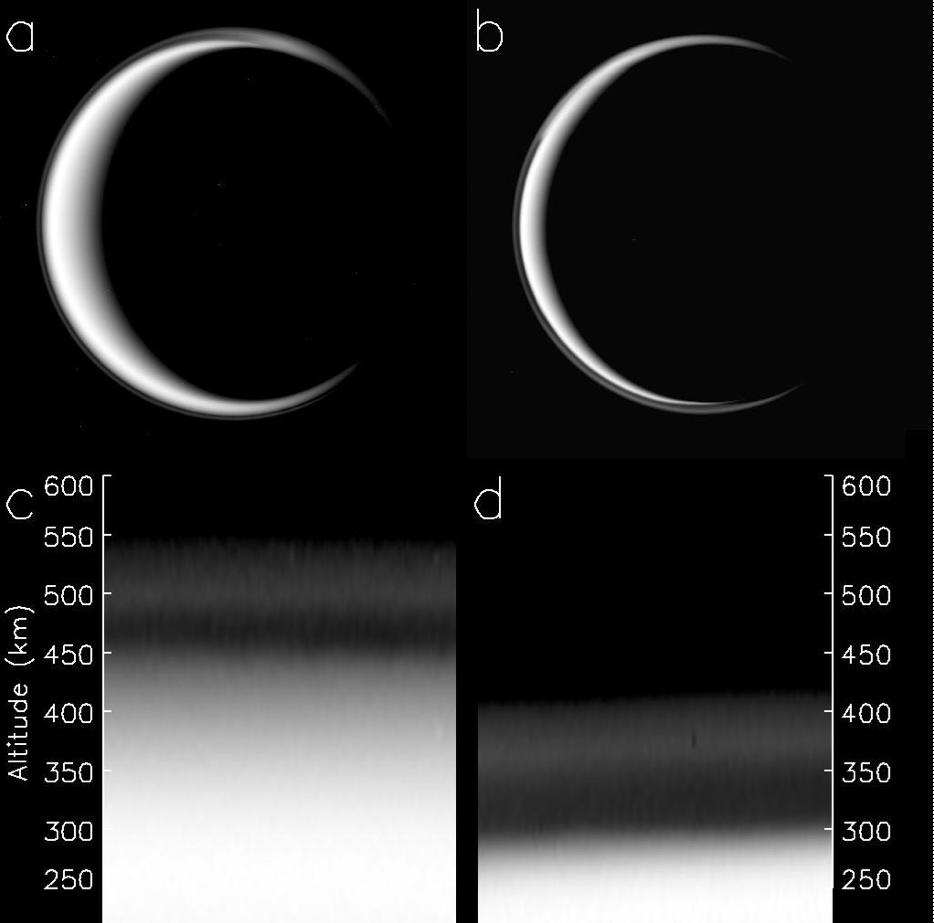
The mosaic above reveals the variations in the altitude of the high-altitude haze of the Orange Moon. The view of the disc in panel "a" was obtained from the Cassini probe on May 3, 2006. The view of the disc in panel "b" was acquired on April 2, 2010. The graphs in panel "c" and "b" show the variation in the altitude of the high-altitude detached haze layer from 2006 to 2010. The upper boundary and the density of this haze may be closely related to seasons. Image credit: NASA/JPL/SSI
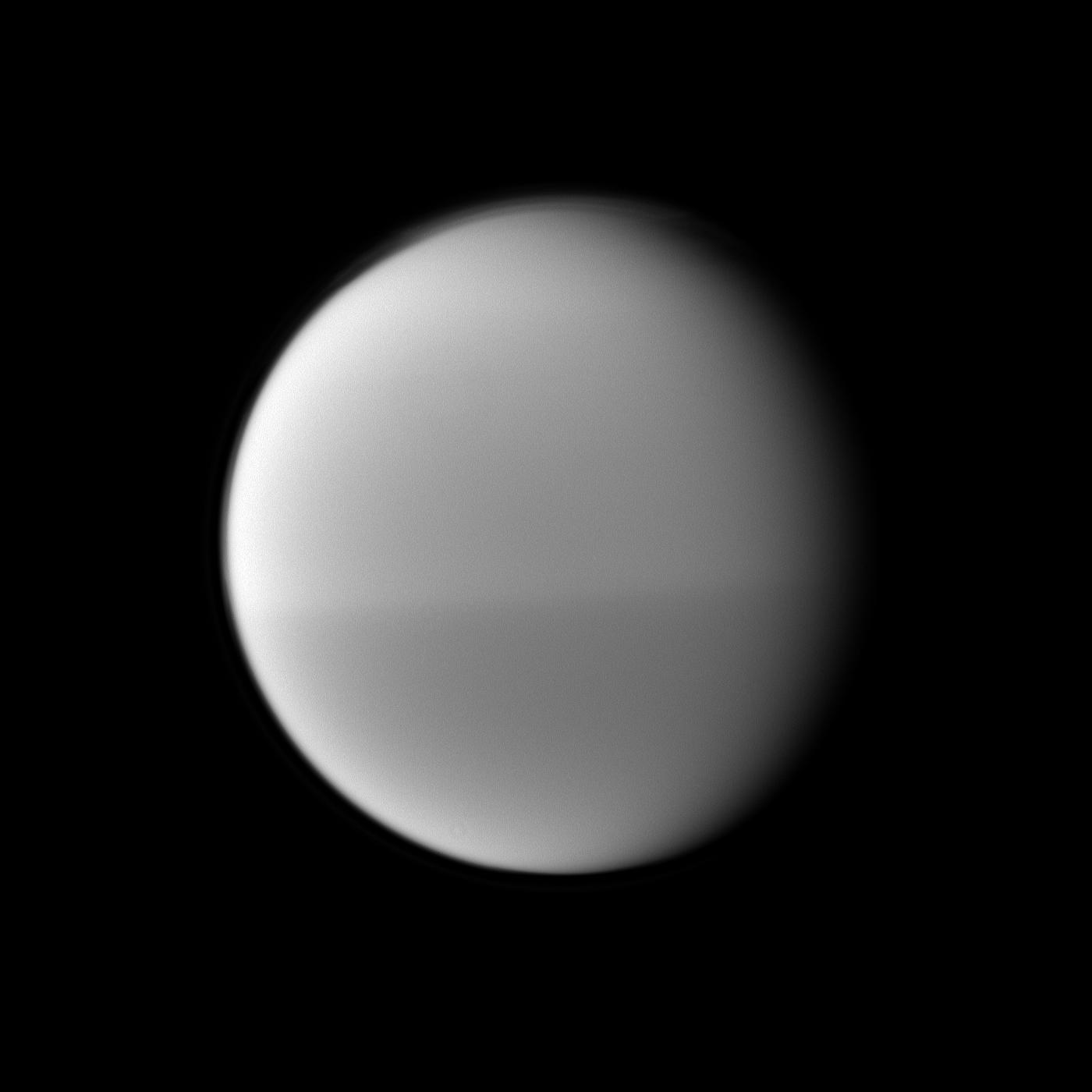
The image of the disk of Titan above reveals the brightness dichotomy between the northern hemisphere and the southern hemisphere. The view was acquired by the narrow-angle camera of the Cassini spacecraft on May 22, 2010. The photo which uses a spectral filter sensitive to wavelengths of near-infrared radiation centered at 889 nanometers shows that the southern hemisphere appears darker than the northern hemisphere at that time. On May 22, 2010, the southern hemisphere was experiencing the beginning of the autumn season and the northern hemisphere was experiencing the beginning of the spring season. These seasons had begun in August 2009 with the equinox. Image credit: NASA/JPL/Space Science Institute
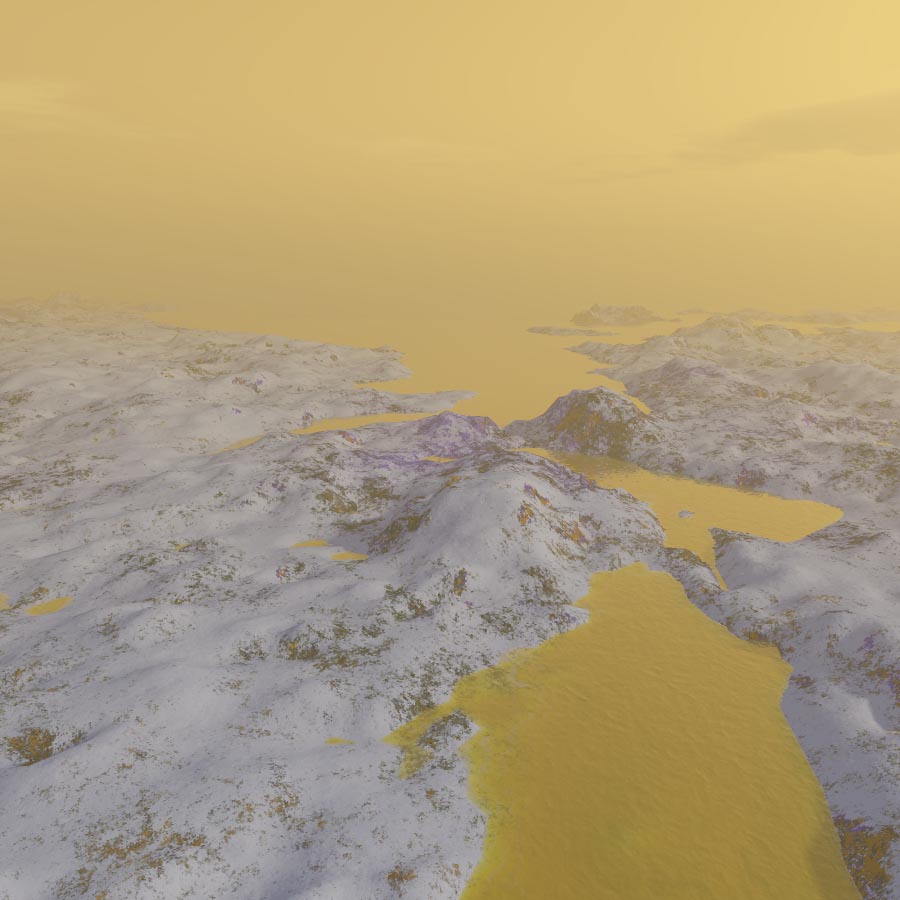 |
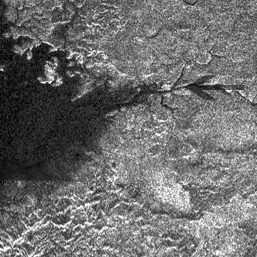 |
| The upper image of the table corresponds to an artistic
view of Ligeia Mare revealing a strong haze at the beginning of the spring
season in the area of this north polar lake. This artistic image is a
computer-generated view based on a radar portion of a delta of Ligeia
Mare obtained on April
10, 2007 from the Cassini probe. The lower view in the table shows the radar portion of the delta of Ligeia Mare represented in the artistic image. The arrow, incorporated into the radar portion, indicates the orientation of the virtual camera in the artistic view. Ligeia Mare can be found between 240 and 250 degrees west longitude and between 70 and 80 degrees north latitude. © Artistic image: Marc Lafferre, 2011 |
- To get further information on that news, go to: http://saturn.jpl.nasa.gov/news/cassiniscienceleague/science20110505.
April 23, 2011: A New Analysis Suggests That Titan's Landscape Is Shaped By Weather Rather Than Cryovolcanism
The Orange Moon, Titan, is an uncommon moon in the Solar System because it is covered with a significant atmosphere and the landscape is relatively varied. Most moons in our Solar System are dominated by a heavily cratered landscape and they have no atmosphere.
Saturn's largest moon appears to be very different from the moon of the Earth regarding many aspects. There is a weather on Titan with active processes on the surface. Thus, our moon has nothing to do with Titan in terms of erosion. The mean density of Titan is largely lower than that of the grey moon we all know. Titan has a mean density of 1.88 g/cm3 compared to 3.35 g/cm3 for our natural satellite.
This difference implies a difference in composition between Titan and the Moon. As a moon of the Outer Solar System, the Opaque Moon Titan is mostly composed of low-density materials such as water ice, frozen carbon dioxide, frozen carbon monoxide, acetylene, ethylene, benzene, liquid methane, liquid ethane, liquid propane or ammonia ice. If there is iron or nickel on Titan, it may not be found on the surface but deeper in the interior or in the core of the icy moon. The concentration of silicon or silicon dioxide (silica) may be lower than that of the Earth or the Moon.
One of the big questions regarding Titan is related to the structure of Titan's interior. Is there an internal ocean of methane, ethane, ammonia or water under the icy crust of Titan? Are there strong energy sources in the interior of Titan which are likely to generate convection movements, geysers or ice volcanoes? Is Titan differentiated or is the internal structure of the moon uniform? Are there geologic layers composed of different materials? Further investigations are needed to answer these major questions.
Scientists know, now, that there is at least one moon of Saturn that is geologically active. The small moon Enceladus unveils eruptions or sprays of water ice in its south polar region. The flows appear to be expelled from topographic fractures or "Tiger Stripes". This surprising geological activity may be related to tidal forces or the gravitational forces of Saturn and the other moons. Therefore, even if Titan moves farther from Saturn than Enceladus, one may reasonably think that the Orange Moon undergoes the tidal forces of Saturn and the other moons.
Scientists are now trying to find clear signs of cryovolcanic activity on Titan but the task is difficult because the atmosphere is opaque to visible light. Scientists manage to identify landscape features on the basis of radar data obtained by the Radar Mapper of the Cassini probe and on the basis of the near-infrared data acquired by the Visual and Infrared Mapping Spectrometer of the Cassini spacecraft.
Titan and Enceladus may be the only moons of Saturn sheltering active ice volcanoes. Tethys, Dione, Rhea and Iapetus seem to be devoid of active surface processes. The bright moons Tethys, Dione and Rhea are heavily cratered contrary to Titan but they host topographic fractures, scarps, cliffs or valleys which implies that the hypothesis of a past cryovolcanism on those moons is not completely ruled out. Can a meteorite hitting the surface of those moons engender a transient icy volcanism? Iapetus is more intriguing than Tethys, Dione and Rhea because it is composed of two kinds of landscapes. Some areas appear dark and some areas appear bright. This shift may result from active surface processes.
The analysis of Titan's landscape reveals that the landscape is diverse and that the meteorology plays a key role in shaping the landscape. The near-infrared and the radar data have allowed scientists to determine that the low latitudes of the Opaque Moon are dominated by dune fields in the optically-dark areas, that the polar regions host lakes, seas and rivers and that the cloud systems are mostly concentrated in the high latitudes of Titan.
The lakes and seas observed in the north polar region or in the south polar region are, a fortiori, fueled by rainfalls of methane and ethane. A large ethane cloud system has been clearly identified in the north polar region and dynamic, transient cloud systems have been regularly observed in the area of Ontario Lacus and Mezzoramia in the south polar region.
Are there lakes, seas or rivers engendered by geysers or ice volcanoes? Some round, circular lakes observed in the north polar region push us into thinking that they may be cryovolcanic in origin. However, the meteorological nature of the lakes, seas and rivers appears to be the dominating hypothesis.
Jeffrey M. Moore, a planetary scientist at NASA's Ames Research Center, Moffet Field, California and Robert T. Pappalardo, a research scientist at NASA's Jet Propulsion Laboratory, Pasadena, California who is a former project scientist for NASA's Cassini mission have just released a study which suggests that the landscape of Titan is shaped by meteorological phenomena rather than from ice volcanoes or an internal activity. The work of the two authors is presented in a paper entitled "Titan: An exogenic world?" in the Journal Icarus in the volume 212, issue 2 of April 2011.
Jeffrey Moore and Robert Pappalardo analyze several candidates for cryovolcanism. The key topographic features on which they focus their attention are Tortola Facula, Ganesa Macula and Hotei Regio. They conclude that exogenic processes dominate on Titan. Some round topographic features are reminiscent of volcanic craters, pancake-shaped domes, volcanoes or calderas but the authors believe that they may rather result from a meteoritic impact. They think that meteorological processes such as rainfall, fluvial processes and aeolian processes play a key role in shaping or eroding the landscape. They don't find any convincing evidence for cryovolcanism.
Jeffrey Moore pointed out: "It would be fantastic to find strong evidence that clearly shows Titan has an internal heat source that causes ice volcanoes and lava flows to form."..." But we find that the evidence presented to date is unconvincing, and recent studies of Titan's interior conducted by geophysicists and gravity experts also weaken the possibility of volcanoes there."
Robert Pappalardo argued: "Titan is a fascinating world."..."Its uniqueness comes from its atmosphere and organic lakes, but in this study, we find no strong evidence for icy volcanism on Titan."
Scientists have always been puzzled by the presence of a significant, deep, thick and dense atmosphere on Titan. Jupiter's largest moon, Ganymede which is bigger and more massive than Titan has no atmosphere whereas Titan has a significant atmosphere. How to explain this paradox? Some scientists have advanced that the atmosphere may result from an active cryovolcanism.
Is the atmosphere of Titan progressively disappearing due to atmospheric gas escaping into outer space? If this atmosphere results from cryovolcanic eruptions, one may assume that the gas layer will be present as long as active eruptions occur. If the atmosphere is in balance and that there is a meteorological cycle between the ground and the atmosphere, one may assume that the atmosphere is related to the right combination of gravity and temperature or environmental energy to keep the gas of the atmosphere from escaping into outer space.
Titan's atmosphere is mostly composed of molecular nitrogen. Methane concentration in the atmosphere is equal to about 2 or 3% of the total composition. The persistent presence of methane in the atmosphere is surprising because it should disappear over time. Its lifespan is around 10 million years. As a result, some scientists argue that an internal source must be replenishing the atmosphere with methane. In other words, methane and ethane could be released into the atmosphere by geysers or cryovolcanoes. The ultraviolet light in the outer atmosphere of Titan tends to break up methane gas into other molecules such as HCN (Hydrogen Cyanide), H2, ethane or radicals.
A recent study has revealed that a surface feature known as Sotra Facula may be the best candidate for a potential ice volcano. Moreover, several parallel scarps, cliffs or fractures suggest tectonic movements on Titan. However, Jeffrey Moore and Robert Pappalardo don't find the observations very convincing regarding the cryovolcanic hypothesis.
The recent observation of low-latitude cloud systems has shown that a dynamic, active meteorology can take shape in the Tropical area, over a Titan year. The hypothesis that the drainage channels observed by the Huygens probe on January 14th, 2005 are related to methane or ethane rain is strengthened by these observations. There may be seasonal rainfall in the low latitudes, in the dark area of Shangri La, in the dark Fensal and Aztlan or in the bright Adiri.
The equinox occured in August 2009. The northern hemisphere is, now, experiencing the spring season and the southern hemisphere is currently in the Autumn season. A season lasts roughly seven Earth years and a year is roughly 29.5 Earth years. The Seif dunes shaped by prevailing winds in the Tropical area seem to be the outcome of erosion related to seasonal rainfall. Precipitations and evaporation processes help generate sand and dune fields.
Titan may be a geologically inactive moon with no subsurface ocean, no convection movements and no geysers or volcanoes. Titan may be comparable to the second largest moon of Jupiter Callisto as Jeffrey Moore argued: "Titan is most akin to Jupiter's moon Callisto, if Callisto had weather."..."Every feature we have seen on Titan can be explained by wind, rain and meteorite impacts, rather than from internal heating."
Yet, the debate on cryovolcanism continues. There is no unanimity regarding the exact nature of Sotra Facula, Hotei Arcus or Ganesa Macula and several moons in the Solar System host a remarkable cryovolcanic activity. The Jovian moon, Io, is probably the best example of volcanism. Triton, the largest moon of Neptune, is filled with geysers, the Black Smokers and it has a thin atmosphere. Enceladus is the smallest moon, known to have a cryovolcanic activity.
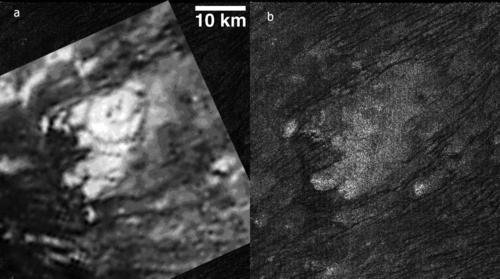
The mosaic above reveals Tortola Facula, a landscape feature which may represent an ice volcano. The left view was captured by the Visual and Infrared Mapping Spectrometer on October 26, 2004. The image on the right corresponds to the same area acquired by the Radar Mapper on May 12, 2008. The area is centered around 9 degrees north latitude and 145 degrees west longitude. Tortola Facula appears bright in the near-infrared view because of its roughness, its relief or because of a reflective surface (water ice? frozen carbon dioxide?...). Image Credit: NASA/JPL/ University of Arizona
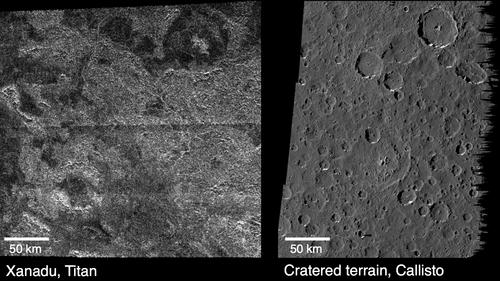
The mosaic above reveals a portion of the bright region of Xanadu on Titan and a portion of the cratered terrain of Callisto, the second largest moon of Jupiter. The left view which corresponds to a radar image of Xanadu centered on 10 degrees south latitude and 85 degrees west longitude was obtained on April 30, 2006 from the Cassini probe. The view of Callisto on the right which is centered on 6 degrees south latitude and 7 degrees west longitude was acquired from the Galileo spacecraft on June 25, 1997. The confrontation of these landscapes enables us to notice that erosional processes are much more pronounced on Titan than on Callisto due to the dense atmosphere of Titan which generates winds, rainfall of methane and ethane as well as lakes, seas or rivers. A few circular features associated with meteorite impacts or a cryovolcanic activity can be seen in the area of Xanadu. Are they calderas, cryovolcanoes or impact craters? The debate continues. Image credit: NASA/JPL
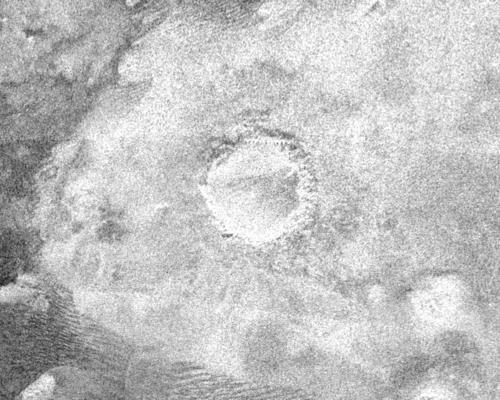
The radar image above, acquired by the Radar Mapper of the Cassini probe on February 15, 2005, reveals Sinlap, a crater located in the north east of the Fensal area. Sinlap is centered on 11.3 degrees north latitude and 16 degrees west longitude. The crater is about 80 km or 50 miles in diameter. Sinlap appears bright in the radar view which implies a rough surface, an elevated terrain or a reflective material on the surface. Is Sinlap an impact crater or is it a caldera or an ice volcano? Image Credit: NASA/JPL
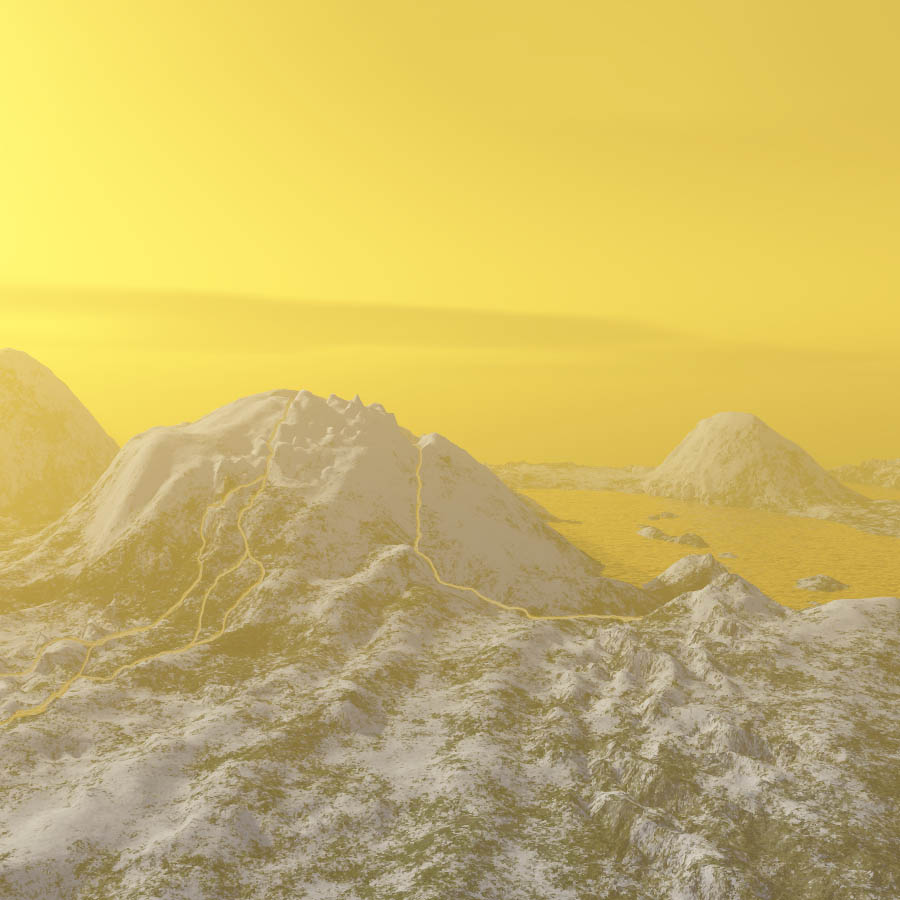
The artistic view above represents an hypothetical cryovolcanic area in the high latitudes of the northern hemisphere. Several pancake-shaped domes can be seen. The ice volcanoes spew mixtures of water ice, frozen carbon dioxide and hydrocarbons such as methane, ethane and propane. Rivers of liquid methane and ethane can be noticed on the volcano in the foreground. Image credit: Marc Lafferre, 2011
- To get further information on that news, go to: http://saturn.jpl.nasa.gov/news/cassinifeatures/feature20110407.
April 2, 2011: Large Tropical Clouds, Recently Observed, May Have Brought Rain and Floods in the Dark Belet Area
Recent near-infrared images of Saturn's largest moon, Titan, reveal unusual cloud formations at low latitudes. Previous images acquired from the Cassini probe had shown that the Tropical or Equatorial regions appear to be mostly arid or dry. The Tropical band is made of optically-dark areas and bright areas and radar images have shown that the low-albedo areas of the Tropical regions are dominated by Seif dunes or parallel dunes which extend over long distances.
Since its arrival in 2004 in the Saturn System, the Cassini spacecraft has unveiled a myriad of near-infrared, ultraviolet or radar images which provide significant clues on the complexity of Titan's weather and climate.
The recent observations of large cloud systems at low latitudes demonstrate that the long seasons of the Orange Moon tend to play a key role in the distribution and dynamics of cloud formations. A year on Titan lasts almost 30 Earth years and a Titanian year is roughly 7 Earth years long. The winter period in the northern hemisphere and the summer period in the southern hemisphere came to an end in August 2009. The northern hemisphere is now advancing in the spring season whereas the southern hemisphere is experiencing the Autumn season.
The near-infrared images obtained with the narrow-angle camera or wide-angle camera had shown that methane or ethane clouds were mostly concentrated in the polar regions of the Opaque moon. Large, dynamic cloud systems were clearly identified in the near-infrared views of the south polar region during the summer period. A large cloud system engulfing the north polar region was also observed during the winter period in the northern hemisphere. Mid-latitude cirrus-like clouds were, sometimes, observed and the equatorial region appeared to be free or quasi-free of clouds until the recent near-infrared observations.
This surprising distribution and dynamics of clouds across the Orange moon has led specialists to postulate that the meteorology is closely related to seasons or changes in seasons. Temperature variations may play a key role for the mechanics of the methane or ethane cycle. The radar images captured by the radar mapper of the Cassini probe have unveiled large concentrations of lakes and seas in the north polar region as well as a sea or a big lake in the south polar region.
The pools of liquids are probably made of mixtures of methane, ethane and propane. Some lakes and seas have been given names. The largest pool of liquids in the north polar region appears to be Kraken Mare followed by Ligeia Mare and Punga Mare. Ontario Lacus is the largest body of liquids in the south polar region. The association of clouds and liquid bodies in the same area reveals the methane and ethane cycle which takes shape on Titan. A parallel can be drawn with the water cycle on our planet. The methane or ethane clouds tend to develop in the Troposphere of Titan which corresponds to the lower atmosphere.
The observations of an arid, dry landscape in the low latitudes of the moon are surprising because the Huygens probe which landed in the Adiri/Shangri La region on January 14, 2005 took aerial photos showing branching networks of drainage channels in the bright hills of Adiri. The methane seas were absent in the Huygens landing site in the low latitudes of the southern hemisphere. That seemed to be a paradox hard to explain. However, since the equinox of 2009, the weather in the Tropical region appears to be radically changing with two large cloud systems observed at different times in late 2010.
A narrow-angle camera view obtained on September 27, 2010 unveiled a giant arrow-shaped storm more than 1000 kilometers (625 miles) long in the low latitudes of the Opaque Moon. Subsequent near-infrared views unveiled changes in appearance in the southern boundary of the optically-dark Belet. The near-infrared views of the area of Belet, acquired at different times reveal areas which have become darker due to the passage of the storm. The albedo changes imply a wetting of the area, related to methane or ethane rain.
It's likely that some dune fields have absorbed liquid hydrocarbons and that floods have occured. Some brightness changes have also been identified in the bright Adiri, to the east of Belet. Some areas of the bright topography appear brighter after the storm which implies that rainfalls have probably washed some steep landforms. Some scientists also hypothesize that the brighter patches may be related to surface or low-altitude fog. The albedo changes in the region of Belet appear to cover an area of approximately 500,000 square kilometers or 193,000 square miles, which corresponds to a surface area a little smaller than France.
The observation of the arrow-shaped cloud of September 27, 2010 was followed by the observation of an elongated, large cloud system in the low latitudes above Fensal-Aztlan on October 18, 2010. The amount of solar illumination generated in the low latitudes since the equinox of 2009 may have engendered a rising motion of methane and ethane within the Tropics. That may explain the sudden presence of large cloud systems in the Tropical desert dominated by dunefields.
The specialists anticipate that the low-latitude bands of clouds will move to much higher latitudes as the Orange Moon approaches the Solstices. The orbital parameters of Titan appear to favour significant meteorological changes related to seasons. The distance to the Sun varies greatly over the 29.5 year-revolution around the Sun and the obliquity of the moon is close to 27 degrees which is more than that of the Earth. Those parameters imply permanent changes in the amount of solar energy reaching the atmosphere and the soil.
It appears, on the basis of observations, that the surface temperature responds more rapidly to sunlight variations than does the thick, dense and deep atmosphere. Since Titan orbits at a mean distance of about 1.42 billion km or 887.5 million miles from the Sun which is approximately 10 times farther than the orbit of the Earth, the solar energy reaching the Orange Moon is particularly low around 15 W/m². And only a fraction of this energy reaches the surface.
The deep and dense atmosphere of Titan appears to generate a small greenhouse effect. Thus, the surface temperature in the low latitudes is about -179 degrees Celsius, -290 degrees Fahrenheit or 94 K. Due to the low level of energy reaching the soil, it appears surprising to observe significant changes related to seasonal phenomena.
Elizabeth Turtle, who is a Cassini imaging team associate at the Johns Hopkins University Applied Physics Laboratory in Laurel, Maryland pointed out: "It's amazing to be watching such familiar activity as rainstorms and seasonal changes in weather patterns on a distant , icy satellite."..."These observations are helping us to understand how Titan works as a system, as well as similar processes on our own planet."
The elongated Tropical cloud systems are reminiscent of cloud formations in the Intertropical Convergence Zone (ITCZ) on Earth. Tony Del Genio of NASA's Goddard Institute for Space Studies, New York, who is a member of the Cassini imaging team, advanced: "These outbreaks may be the Titan equivalent of what creates Earth's tropical rainforest climates, even though the delayed reaction to the change of seasons and the apparently sudden shift is more reminiscent of Earth's behavior over the tropical oceans than over tropical land areas."
Carolyn Porco, Cassini imaging team lead at the Space Science Institute , Boulder, Colorado insisted: "It is patently clear that there is so much more to learn from Cassini about seasonal forcing of a complex surface-atmosphere system like Titan's and, in turn, how it is similar to, or differs from, the Earth's."..."We are eager to see what the rest of Cassini's Solstice Mission will bring."
The current meteorological configuration and evolution allows us to extrapolate, forecast or postulate the evolution in the dynamics and distribution of clouds and liquid bodies in the coming years. It poses some questions, as well. Will there be more clouds and a higher concentration of liquid bodies in the south polar region as the winter season approaches? Will there be a lower concentration of clouds and liquid bodies in the north polar region as the summer season approaches? How often does the rainfall occur in the Tropical region?
Marc Lafferre, a specialist of Titan, notes that the repetition of precipitation and evaporation processes in the low latitudes during a Titan year may account for the presence of dune fields because of strong erosional processes combined with prevailing winds which help create the "Cat Scratches" or Seif Dunes.
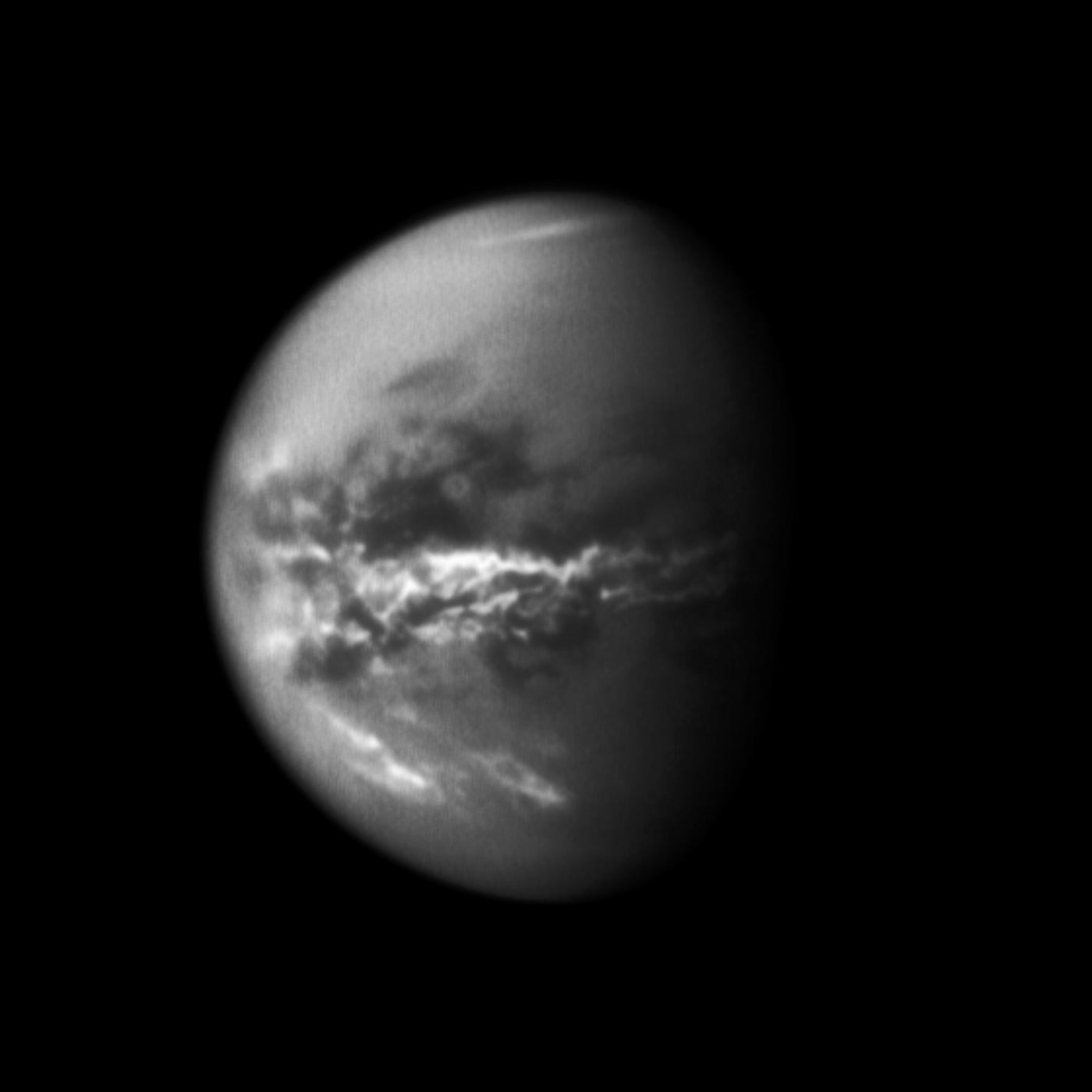
The near-infrared view of Titan above unveils unusual cloud formations over the dark Tropical region Fensal/Aztlan. This observation occured on October 18, 2010 a little more than one Terrestrial year after the equinox which happened in August 2009. The northern hemisphere of the Orange Moon is now in the spring season whereas the southern hemisphere is in the autumn season. Image source: NASA/JPL/SSI

The arrow-shaped cloud above was observed on September 27, 2010. This image corresponds to a near-infrared view obtained with the narrow-angle camera of the Cassini spacecraft. This cloud system may have produced rainfalls in the low latitudes of the moon. Image source: NASA/JPL/SSI

The series of near-infrared views above shows an area centered at 19 degrees south latitude, 251 degrees west longitude at different times. The first image from the left was taken on October 22, 2007. The second view was obtained on September 27, 2010. The third image was obtained on October 14, 2010. The fourth image was acquired on October 29, 2010. The fifth image represents the area on January 15, 2011. One can observe cloud formations moving in the area as well as a change in appearance along the southern boundary of the dark Belet. This change in appearance may be related to recent rainfalls of methane or ethane. Image source: NASA/JPL/SSI
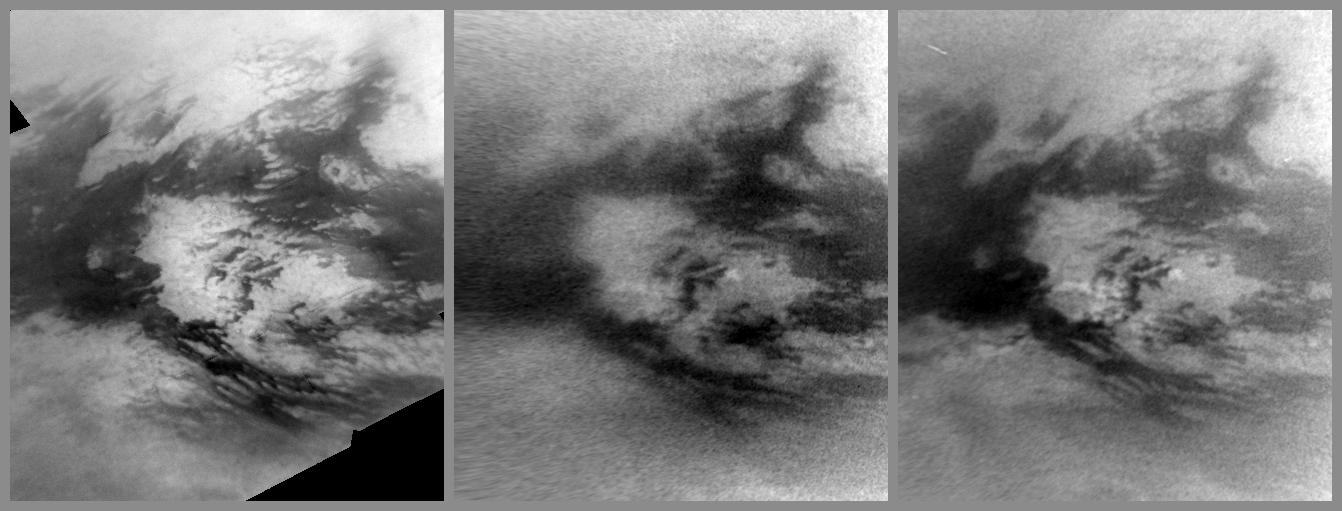
This mosaic of near-infrared images reveals the area of the bright Adiri and the dark Shangri La. The first image from the left was obtained on May 13, 2007. The second and the third image were acquired on January 15, 2011, 15 hours apart. One can observe particularly bright patches appearing within the bright area in the second and third image. They may correspond to slopes which have been washed clean by methane rains or it may be related to surface fog. Image source: NASA/JPL/SSI
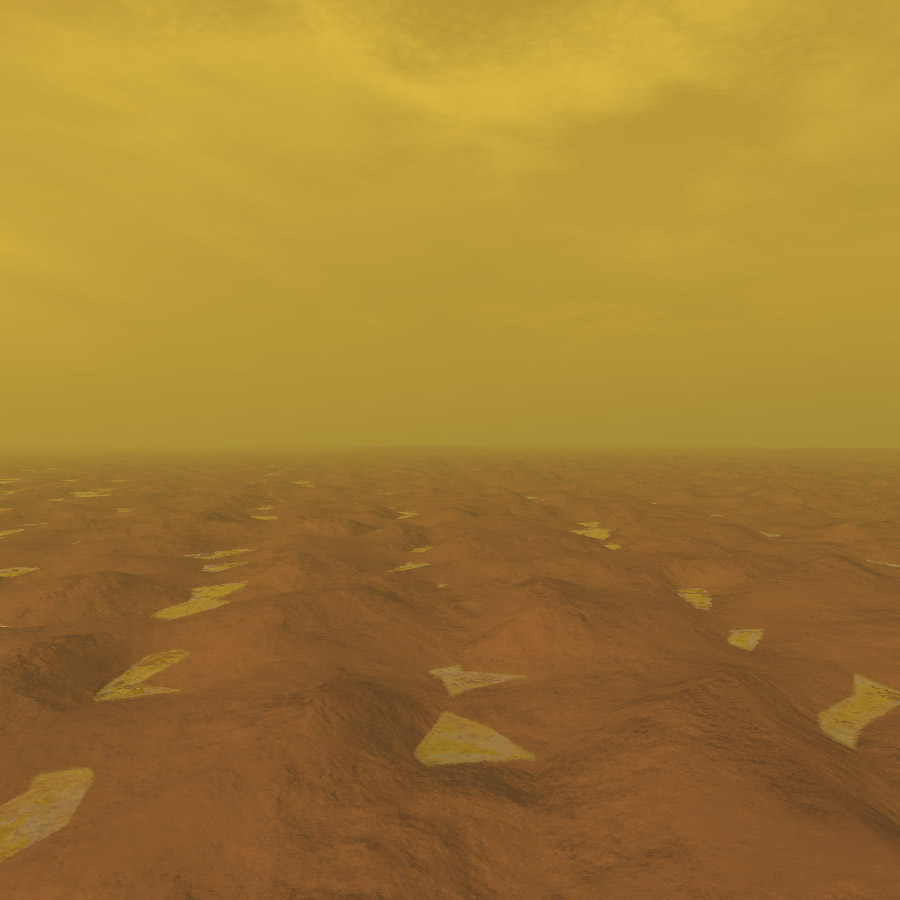
The artistic view above represents a computer-generated image of the southern boundary of the dark Belet after the passage of the arrow-shaped cloud which was observed on September 27, 2010 by the narrow-angle camera of the Cassini probe. The area is dominated by Seif dunes, "Cat scratches" or parallel dune fields extending over long distances. The change in appearance observed by the near-infrared eye suggests a wetting process or floods in the area. Image credit: Marc Lafferre, 2011.
- To get further information on that news, go to: http://saturn.jpl.nasa.gov/news/newsreleases/newsrelease20110317.
February 11, 2011: Bright Cirrus-Like Clouds Identified in the High Altitudes of Titan's Opaque Atmosphere
Saturn's largest moon Titan harbors a surprising atmosphere containing exotic ingredients. Titan is the only moon in the Solar System with a significant atmosphere. The largest moon of Jupiter, Ganymede, is devoid of any significant atmosphere for instance.
The opaque, orange, deep, hazy atmosphere of Titan is mostly composed of nitrogen as Voyager 1 had revealed during its Titan flyby in 1980. One of the major particularities of this atmosphere is the presence of large amounts of methane. Multiple organic compounds or hydrocarbons have been identified as well.
The ultraviolet radiations from the Sun interact with methane in the upper atmosphere of the Orange Moon to form new hydrocarbons or organics such as acetylene (C2H2), ethylene (C2H4), radicals or nitriles such as hydrogen cyanide (HCN).
The Visual and Infrared Mapping Spectrometer (VIMS) of the Cassini spacecraft has unveiled multiple cloud formations in the south polar region, in the north polar region as well as at mid-latitudes. The clouds are more abundant in the polar regions where seas or lakes of methane and ethane have been spotted via radar images.
The north polar region which experienced the winter season for seven years until August 2009 reveals a giant cloud formation made of ethane engulfing the whole area. This cloud system appears to be a polar vortex reminiscent of a vortex in the south polar region of Venus.
Recent near-infrared or infrared views of the tropical regions of Titan have revealed dynamic cloud formations in areas which are generally free of clouds. The seasons may play a key role in the dynamics and distribution of cloud systems. A year lasts roughly 29.5 Terrestrial years and a season lasts around seven Terrestrial years. As a result, scientists need to study Titan during at least one revolution around the Sun.
Titan's atmosphere which presents some similarities with the atmosphere of the Blue Planet appears particularly complex and new findings are regularly reported regarding the composition or the dynamics of the orange atmosphere of Titan.
A team led by Carrie M. Anderson and Robert E. Samuelson has just reported the discovery of bright cirrus-like clouds at high altitudes in the smoggy atmosphere of the icy moon. The finding was made possible thanks to the Composite Infrared Spectrometer (CIRS) of the Cassini probe. The paper on the finding, entitled "Analysis of Cassini/CIRS limb spectra of Titan acquired during the nominal mission II: Aerosol extinction profiles in the 600-1420 cm^-1 spectral range" was published in Icarus on February 1, 2011.
In a haze which can be far worse than a smog in Beijing, thin, white, wispy clouds of ice particles can be encountered. One may say that the ice clouds have the white appearance of freshly fallen snow. The cirrus-like clouds evolve higher in the atmosphere than the typical methane and ethane clouds which are easily identified in near-infrared or infrared images.
Robert E. Samuelson who is at NASA's Goddard Space Flight Center in Greenbelt, Maryland pointed out: "This is the first time we have been able to get details about these clouds."..."Previously, we had a lot of information about the gases in Titan's atmosphere but not much about the [high-altitude] clouds."
These particular cirrus-like clouds are difficult to identify because they are much thinner than the large cloud formations evolving lower in the atmosphere. Carrie M. Anderson from NASA's Goddard Space Flight Center, Greenbelt, Maryland argued: "They are very tenuous and very easy to miss."..."The only earlier hints that they existed were faint glimpses that NASA's Voyager 1 spacecraft caught as it flew by Titan in 1980."
The amount of solar energy reaching the gas layer of Titan is very low since the moon orbits the Sun in the Outer Solar System at a mean distance of about 1.43 billion kilometers or 890 million miles from the Sun. As a result, the temperature on Titan's surface is around -179 degrees Celsius, -290 degrees Fahrenheit or 94 Kelvin and molecules such as methane, ethane and propane can appear as gas or as liquid bodies on the surface.
In this frigid, cryogenic environment, clouds of water or icy water are not found. The atmosphere is devoid of significant amounts of oxygen as well. The atmosphere remains dominated by hydrocarbons or organics which can form clouds at different altitudes in a deep, opaque and dense atmosphere. Let's recall that the atmospheric pressure on the surface is higher than that of the atmosphere on Earth. The Huygens probe recorded an atmospheric pressure of 1467 hPa or milliBars on the surface on January 14, 2005.
The processes of cloud formation are closely related to concentrations of hydrocarbons, to temperatures or temperature variations. Hence, one can observe clouds in the stratosphere. One can find ices made from some exotic organic materials. Scientists have detected complex processes involving organics in the atmosphere and more than six hydrocarbons have been spotted in gas form in the atmosphere of the hazy moon.
Carrie M. Anderson explained: "You can learn a lot about a compound, even if you have no idea what it is, by looking at how it is distributed vertically." Many questions are raised by the observations as she pointed out: "Where does it accumulate? Where does it dissipate? How thick is the boundary? Is there layering going on?"
The cirrus-like clouds of the upper atmosphere can be identified when one observes the edges of the disk via images of the CIRS instrument. Carrie Anderson underlined: "These beautiful, beautiful ice clouds are optically thin, and they're diffuse."..."But we were able to pick up on them because of the long path lengths of the observations." Carrie M. Anderson, Robert E. Samuelson, Michael Flasar, Gordon L. Bjoraker and their colleagues are now in a position to determine the mean size of the ice particles of the cirrus-like clouds.
What is the circulation pattern of these high-altitude clouds over the globe? It seems that seasons and temperature variations play a key role. Due to the relatively high obliquity of Titan's rotation axis and due to significant distance variations of the orbit of Titan around the Sun, the meteorological changes between seasons can be considerable.
The seasonal configuration with the winter season in the northern hemisphere and the summer season in the southern hemisphere has revealed, on the basis of VIMS observations and radar images of the Cassini probe, a dichotomy between the northern hemisphere and the southern hemisphere regarding the distribution of clouds and liquid bodies on the surface.
The north polar region harbors a large concentration of lakes and seas and a giant ethane cloud similar to a hurricane. The south polar region harbors fewer lakes and frequent dynamical cloud systems which tend to dissipate rapidly. The recent observation of tropical or equatorial elongated clouds reveals the impact of seasonal changes on Titan. The northern hemisphere is now in early spring whereas the southern hemisphere is in early autumn.
It is likely that the clouds migrate from the pole in the warmer hemisphere to the pole in the colder hemisphere where the gas sinks. Carrie Anderson advanced: "At colder temperatures, more gas will condense anyway."..." and on top of that, the atmosphere dumps a whole bunch of extra gas there."
When the Voyager 1 spacecraft observed Titan in November 1980, the north had just passed from winter into spring. Therefore, the seasonal configuration was similar to that of today in that area. The observations of the team have shown that the clouds in the north are three times more plentiful than those just south of the equator.
Michael Flasar, the Principal Investigator for CIRS argued: "The fact that the clouds are more enhanced at the cold polar region is a promising sign."..."It strengthens this idea that the molecules making up these clouds are being carried downward by this global circulation."
The cirrus-like clouds can be made of different ice particles. Cyanoacetylene for instance, which is a nitrile, was identified in the northern ice clouds by Voyager 1. The team hopes to find hydrogen cyanide, another nitrile, in the clouds, as well. Larger molecules or larger hydrocarbons may be found very soon in the aerosol. Some signatures may reveal the presence of Polycyclic Aromatic Hydrocarbons (PAHs) in those clouds.
Some scientists advance that the drizzle, the rain of the hydrocarbons or the nitriles remains on the surface. There is precipitation but there is no evaporation process. Robert Samuelson insists: "They fall to the surface, and it's a dead end."..."and yet Titan's atmosphere still has methane in it. We are trying to find out why."
It appears that the frozen nitriles form at relatively high altitudes of about 30 to 60 miles (48 to 96 km) in the Stratosphere. On Earth, for instance, almost all Earth clouds form at lower altitudes in the Troposphere at maximum altitudes of about 11 miles (17.6 km).
The circulation pattern of clouds will be long to study because a Titanian season is seven years long. Winter will come in the southern hemisphere in 2017. Will the north polar clouds migrate to the south polar region? Will there be a reversal in the distribution of clouds? Carrie Anderson argued: "We expect to find a complete reversal in the circulation of gas then."..."The gas should start to flow from the north to the south. And that should mean most of the high-altitude ice clouds will be in the southern hemisphere."
The opaque, deep and dense atmosphere of Titan appears very complex with long term cycles, haze, low-altitude clouds, high-altitude clouds and formations of complex hydrocarbons or organics.
Mike Brown of the California Institute of Technology (Caltech) had unveiled, at the end of 2009, the finding of common fog on Titan. Mike Brown and Barbara Rosenberg argued that the south pole was full of puddles of methane which gave rise to sporadic layers of fog. This finding was made possible thanks to the VIMS of the Cassini probe. This finding may be considered a sign of an active hydrological cycle.
The complex organics or hydrocarbons forming in the upper atmosphere of Titan raise the question of prebiotic molecules. Sarah Horst of the University of Arizona and her collaborators performed laboratory experiments to simulate the atmospheric chemistry of Titan. She advanced: "Titan's skies might do some interesting chemistry - manufacture the building blocks of life."
The experiment involved a mixture of carbon monoxide, molecular nitrogen and methane. To simulate the solar radiation, the team used radio waves applied to the mixture. The outcome turned out to be a rich array of complex molecules, including amino acids and nucleotides.
Sarah Horst argued: "Our experiment is the first proof that you can make the precursors for life up in an atmosphere, without any liquid water. This means life's building blocks could form in the air and then rain down from the skies!" The lab experiment has, notably, revealed five nucleotides found in DNA and RNA, as well as two amino acids.
The oxygen from the geysers of Enceladus entering Titan's atmosphere may bring the ingredients for the formation of building blocks of life. Sarah Horst pointed out: "Water spewing across from the plumes get broken up, releasing hydrogen and oxygen. And the amount of oxygen entering Titan's atmosphere from outside is precisely the quantity needed to make the amount of carbon monoxide detected in that atmosphere."
According to Sarah Horst and her team, life's precursors may be raining down on the surface of Saturn's largest moon but it remains to clearly identify the complex organic molecules detected in Titan's atmosphere.
As Marc Lafferre, a specialist of Titan, notes, no less than a Titan year or 29.5 years may be needed to decipher the complete working of Titan's climate and meteorology. Studying Titan's atmosphere is like assembling a puzzle. That's captivating and it may be useful for our understanding of the Terrestrial meteorology and climate as Jean Jouzel, a French Nobel Peace Prize and a collaborator of the GIEC, recently said in the French TV programme "C Dans l'Air".
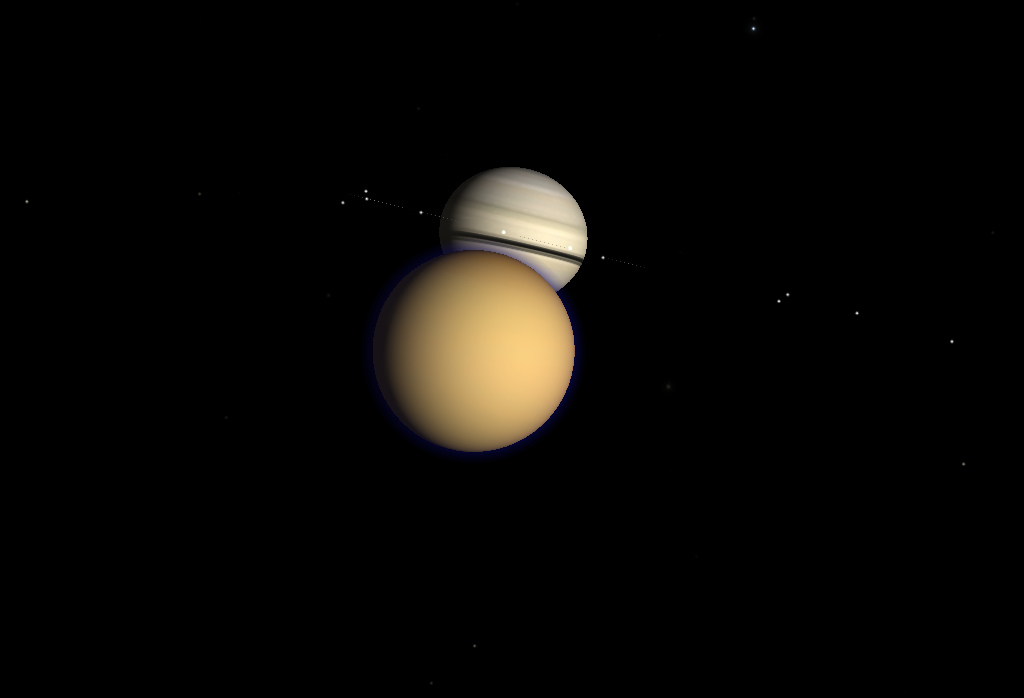
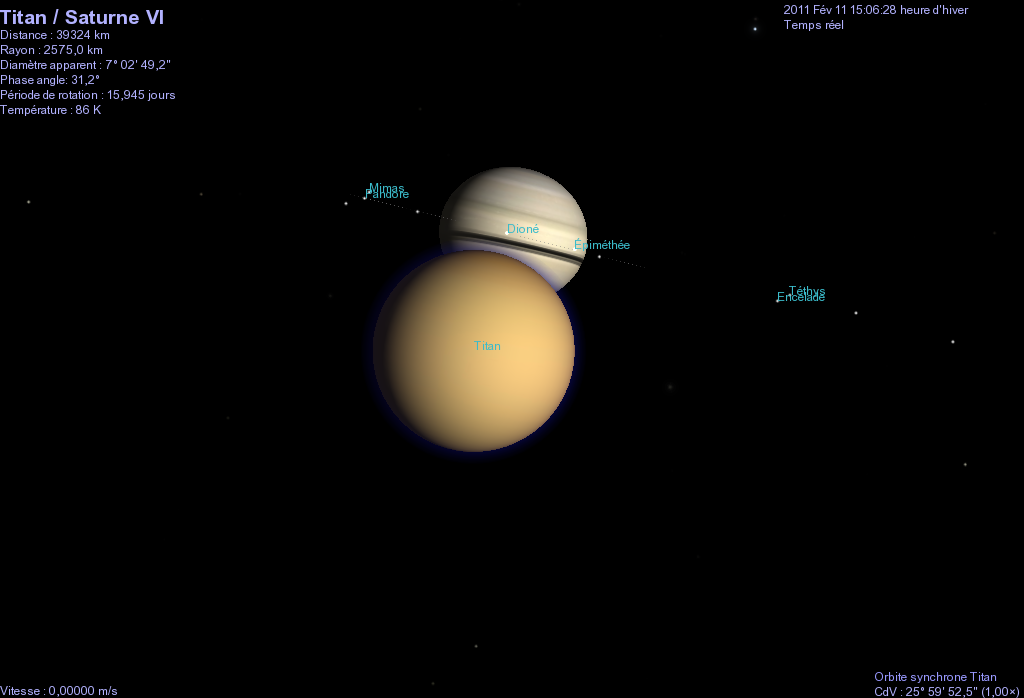
The computer-generated images above correspond to simulated views of Titan in its environment of the Saturn system. The orbital positions of the moons and Saturn are based on data from the software "Celestia" which provides realistic, simulated views of planetary bodies in our Solar System. The image presents the orbital positions of the moons on February 11, 2011 as indicated in the annotated image (lower view). Saturn's largest moon is in the foreground. In this image, the atmospheric texture of Titan is artificial but it remains close to reality. The atmospheric texture was created by Marc Lafferre. Although the color of the Hazy Moon is relatively uniform, one can observe that the north polar region of Titan is a little darker than the rest of the atmosphere. Large cloud formations appear in that area. The edges of the upper atmosphere of Titan tend to appear blue or purple. © Marc Lafferre, 2011
The global view of Titan above corresponds to an artistic view of the Orange Moon. On can observe the dark north polar region in which two unusual high-altitude cloud systems can be noticed. Moreover, the atmospheric edges of the disk clearly reveal the blue/purple detached haze layer which contrasts with the uniform, orange color of the deep and opaque atmosphere. All Rights Reserved: Marc Lafferre, 2011.
- To get further information on that news, go to: http://www.nasa.gov/mission_pages/cassini/whycassini/titan-clouds.html, http://science.nasa.gov/science-news/science-at-nasa/2010/30dec_titan and http://media.caltech.edu/press_releases/13314.
Titan
News 2010
Titan
News 2009
Titan News 2008
Titan
News 2007
Titan
News 2006
Titan News
2004, 2005

